Effectiveness of Braden Scale in ICU Pressure Injury Assessment Review
VerifiedAdded on 2023/03/30
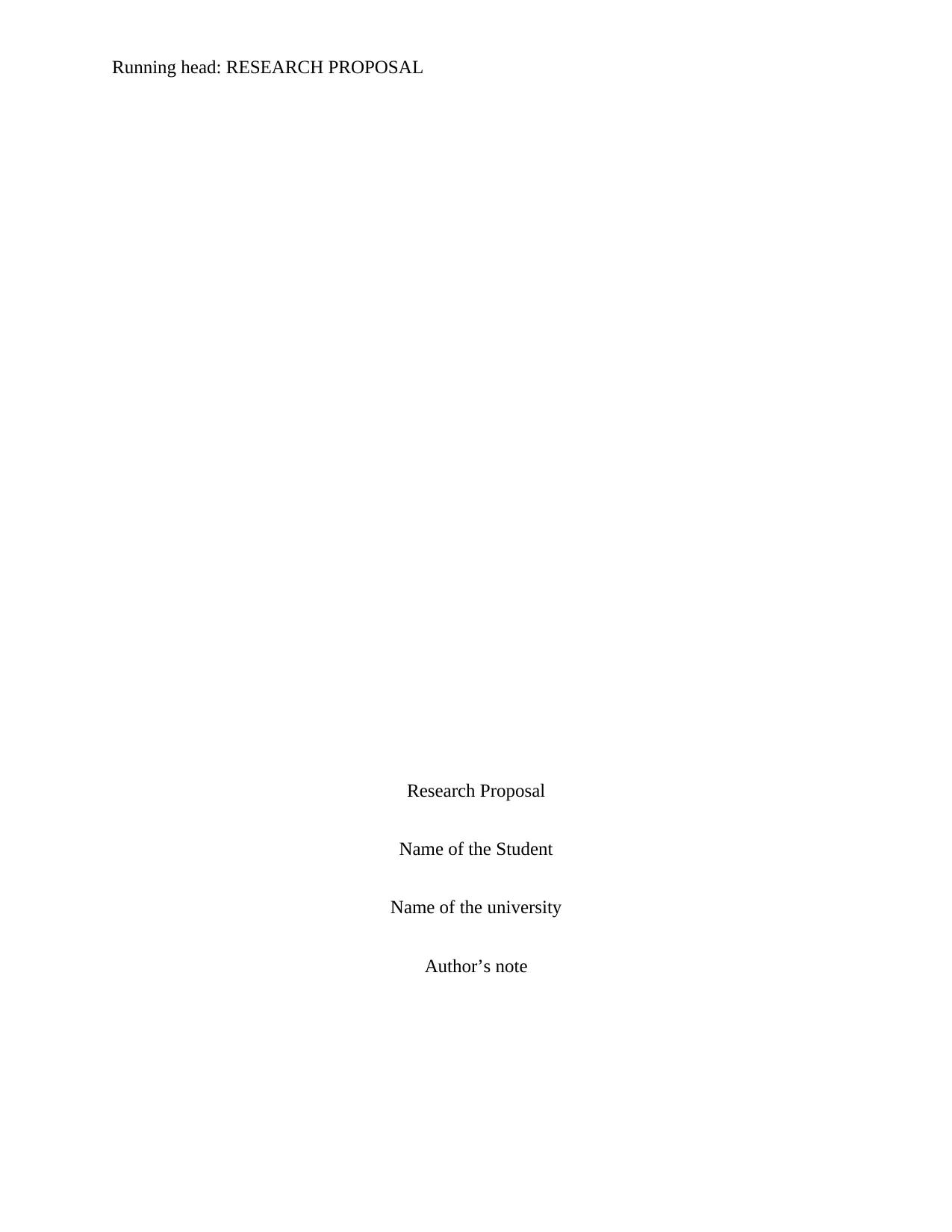
Research Proposal
Name of the Student
Name of the university
Author’s note
Paraphrase This Document
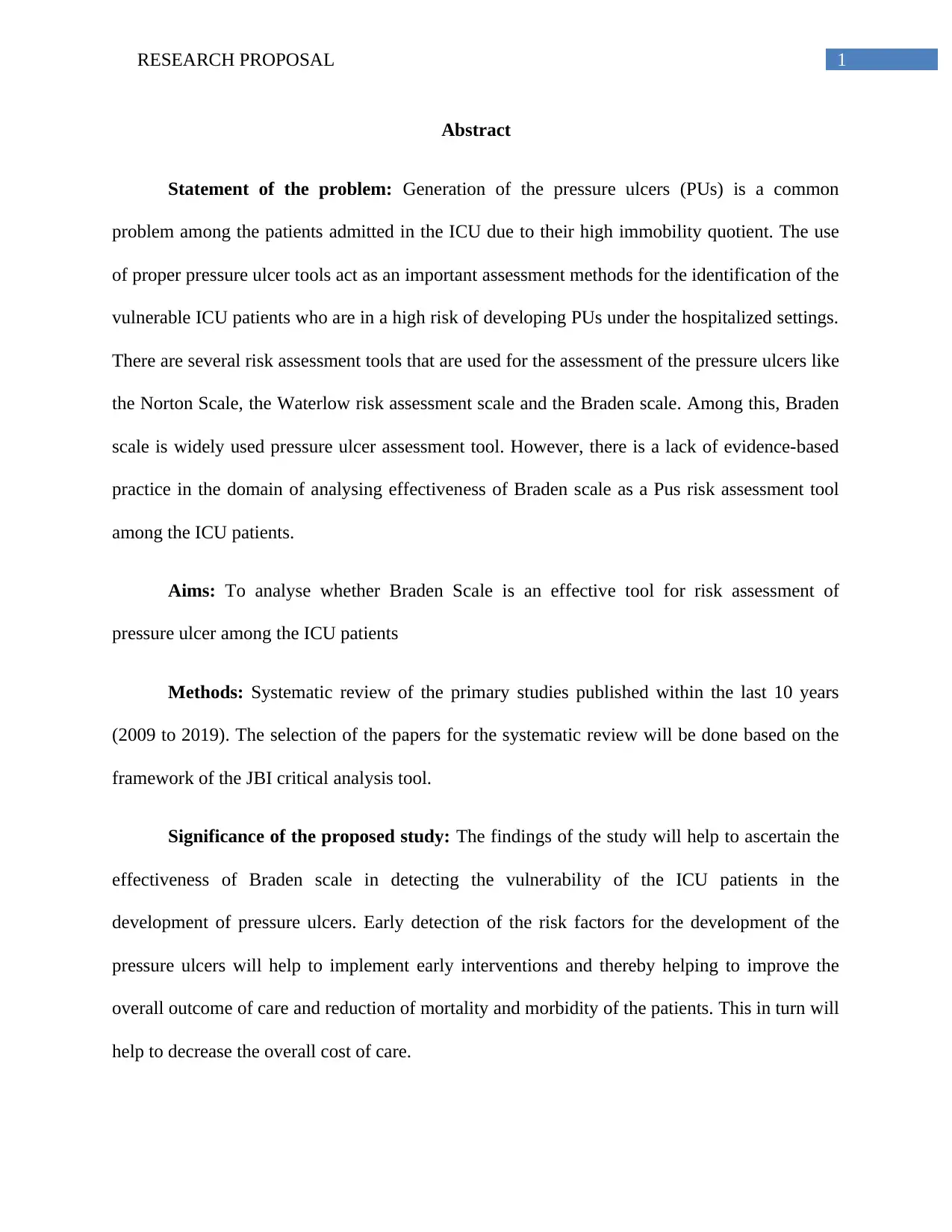
Abstract
Statement of the problem: Generation of the pressure ulcers (PUs) is a common
problem among the patients admitted in the ICU due to their high immobility quotient. The use
of proper pressure ulcer tools act as an important assessment methods for the identification of the
vulnerable ICU patients who are in a high risk of developing PUs under the hospitalized settings.
There are several risk assessment tools that are used for the assessment of the pressure ulcers like
the Norton Scale, the Waterlow risk assessment scale and the Braden scale. Among this, Braden
scale is widely used pressure ulcer assessment tool. However, there is a lack of evidence-based
practice in the domain of analysing effectiveness of Braden scale as a Pus risk assessment tool
among the ICU patients.
Aims: To analyse whether Braden Scale is an effective tool for risk assessment of
pressure ulcer among the ICU patients
Methods: Systematic review of the primary studies published within the last 10 years
(2009 to 2019). The selection of the papers for the systematic review will be done based on the
framework of the JBI critical analysis tool.
Significance of the proposed study: The findings of the study will help to ascertain the
effectiveness of Braden scale in detecting the vulnerability of the ICU patients in the
development of pressure ulcers. Early detection of the risk factors for the development of the
pressure ulcers will help to implement early interventions and thereby helping to improve the
overall outcome of care and reduction of mortality and morbidity of the patients. This in turn will
help to decrease the overall cost of care.
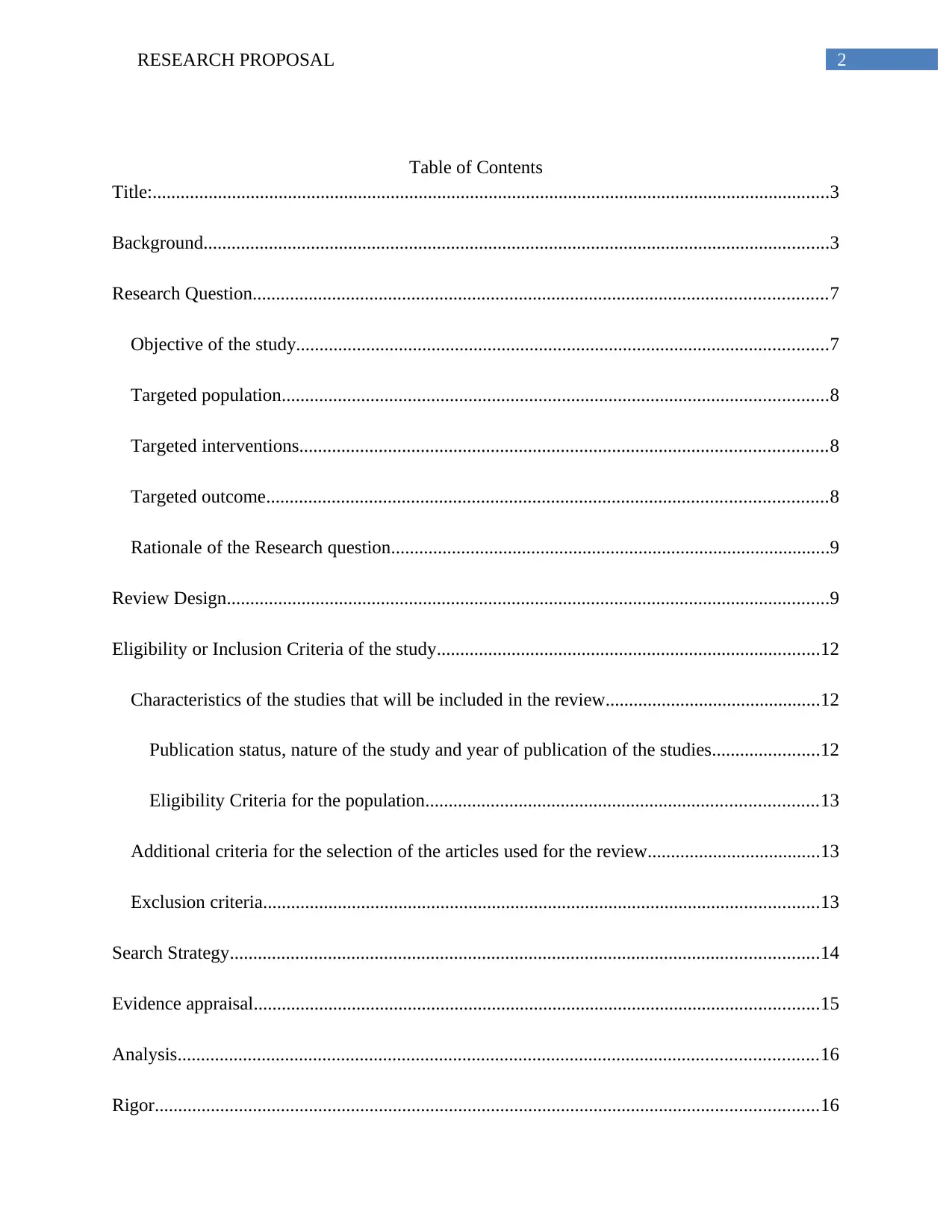
Table of Contents
Title:.................................................................................................................................................3
Background......................................................................................................................................3
Research Question...........................................................................................................................7
Objective of the study..................................................................................................................7
Targeted population.....................................................................................................................8
Targeted interventions.................................................................................................................8
Targeted outcome........................................................................................................................8
Rationale of the Research question..............................................................................................9
Review Design.................................................................................................................................9
Eligibility or Inclusion Criteria of the study..................................................................................12
Characteristics of the studies that will be included in the review..............................................12
Publication status, nature of the study and year of publication of the studies.......................12
Eligibility Criteria for the population....................................................................................13
Additional criteria for the selection of the articles used for the review.....................................13
Exclusion criteria.......................................................................................................................13
Search Strategy..............................................................................................................................14
Evidence appraisal.........................................................................................................................15
Analysis.........................................................................................................................................16
Rigor..............................................................................................................................................16
⊘ This is a preview!⊘
Do you want full access?
Subscribe today to unlock all pages.

Trusted by 1+ million students worldwide
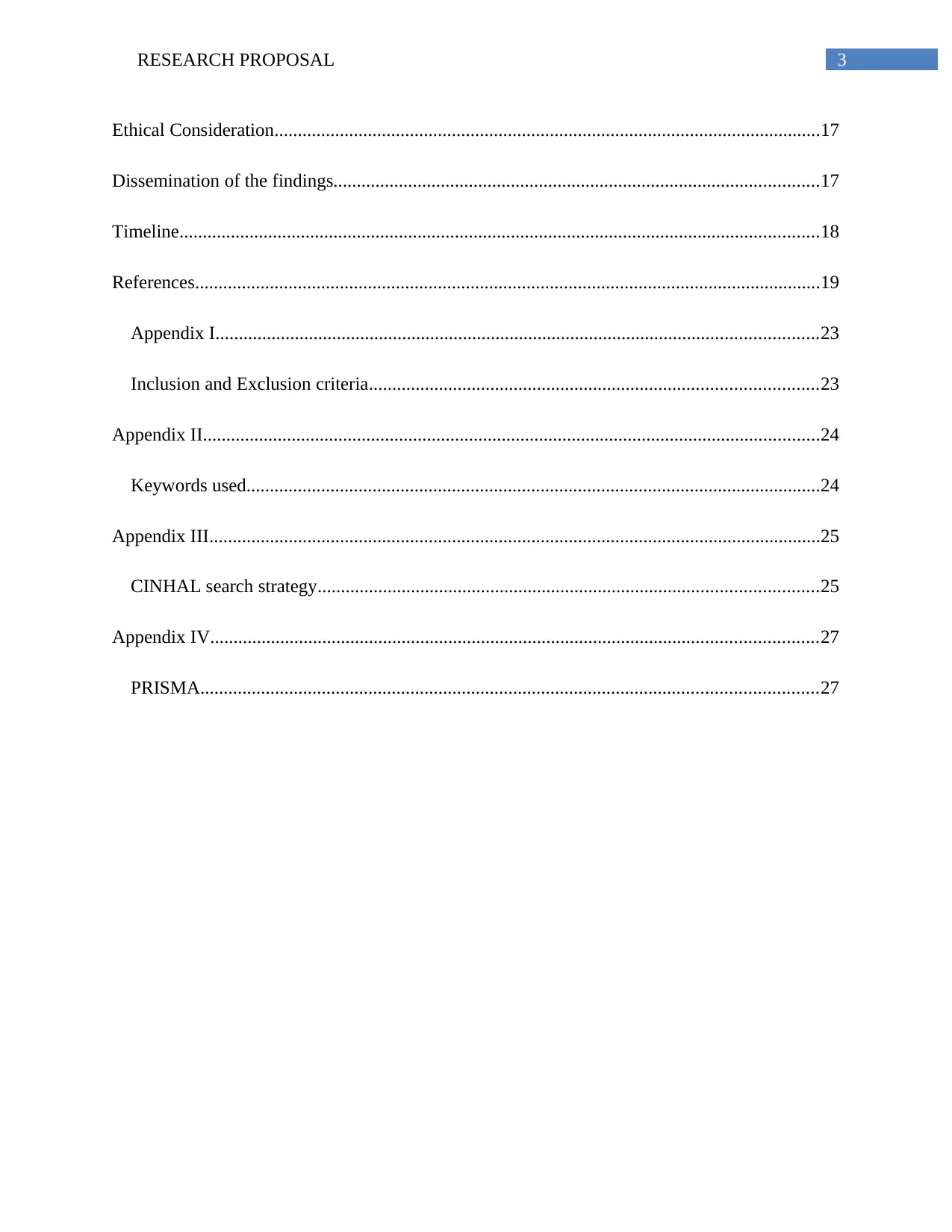
Ethical Consideration.....................................................................................................................17
Dissemination of the findings........................................................................................................17
Timeline.........................................................................................................................................18
References......................................................................................................................................19
Appendix I.................................................................................................................................23
Inclusion and Exclusion criteria................................................................................................23
Appendix II....................................................................................................................................24
Keywords used...........................................................................................................................24
Appendix III...................................................................................................................................25
CINHAL search strategy...........................................................................................................25
Appendix IV..................................................................................................................................27
PRISMA....................................................................................................................................27
Paraphrase This Document

Title:
The topic of the research proposal is: Is Braden scale an effective assessment tool for assessing
pressure injury risk in ICU patients- a systematic review
Background
Pressure ulcers are some complications in the intensive care unit (ICU) patients who are
in a sedated mode or in ventilation or had been immobile for a longer period of time. Although
many studies have highlighted that there is no strong relationship between patient mortality and
pressure ulcers, but patients who have developed pressure ulcers may indirectly contribute to
mortality. Patients who had developed pressure ulcer experience added pain, morbidity and
psychological distress that is related to loss of independence and social isolation (Kottner, et al.,
2016).
Pressure ulcers acquired in the hospital settings acts as a health care indicators in most of
the health care settings. Hospital acquired pressure ulcers have been found be associated with
increased health care costs. Multiple studies have been done discussing about the risk factors of
the pressure ulcers and the skin barriers factor (He, Tang, Ge & Zheng 2016). Globally, the
economic impact of the pressure ulcers is yet to be established. It affects both the community and
the hospital settings. Hence, pressure ulcer assessment and effective prevention strategies are
necessary to reduce the prevalence and the incidence rates. Skin helps in homeostasis by acting
as barriers against any kinds of infections and loss of water and protection against noxious
physical and chemical stimuli present in the nature. Thus skin assessment is an important
component in pressure ulcers.
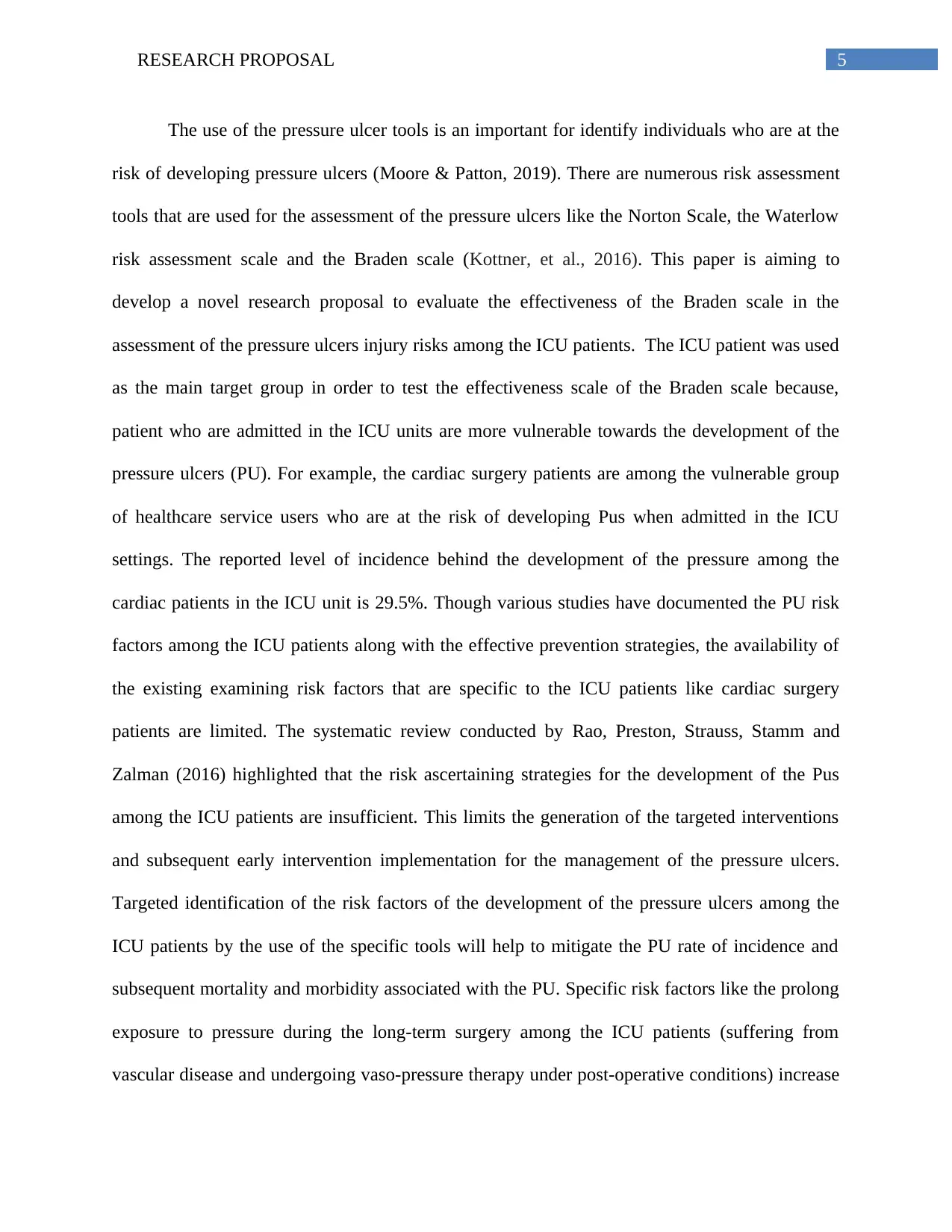
The use of the pressure ulcer tools is an important for identify individuals who are at the
risk of developing pressure ulcers (Moore & Patton, 2019). There are numerous risk assessment
tools that are used for the assessment of the pressure ulcers like the Norton Scale, the Waterlow
risk assessment scale and the Braden scale (Kottner, et al., 2016). This paper is aiming to
develop a novel research proposal to evaluate the effectiveness of the Braden scale in the
assessment of the pressure ulcers injury risks among the ICU patients. The ICU patient was used
as the main target group in order to test the effectiveness scale of the Braden scale because,
patient who are admitted in the ICU units are more vulnerable towards the development of the
pressure ulcers (PU). For example, the cardiac surgery patients are among the vulnerable group
of healthcare service users who are at the risk of developing Pus when admitted in the ICU
settings. The reported level of incidence behind the development of the pressure among the
cardiac patients in the ICU unit is 29.5%. Though various studies have documented the PU risk
factors among the ICU patients along with the effective prevention strategies, the availability of
the existing examining risk factors that are specific to the ICU patients like cardiac surgery
patients are limited. The systematic review conducted by Rao, Preston, Strauss, Stamm and
Zalman (2016) highlighted that the risk ascertaining strategies for the development of the Pus
among the ICU patients are insufficient. This limits the generation of the targeted interventions
and subsequent early intervention implementation for the management of the pressure ulcers.
Targeted identification of the risk factors of the development of the pressure ulcers among the
ICU patients by the use of the specific tools will help to mitigate the PU rate of incidence and
subsequent mortality and morbidity associated with the PU. Specific risk factors like the prolong
exposure to pressure during the long-term surgery among the ICU patients (suffering from
vascular disease and undergoing vaso-pressure therapy under post-operative conditions) increase
⊘ This is a preview!⊘
Do you want full access?
Subscribe today to unlock all pages.

Trusted by 1+ million students worldwide
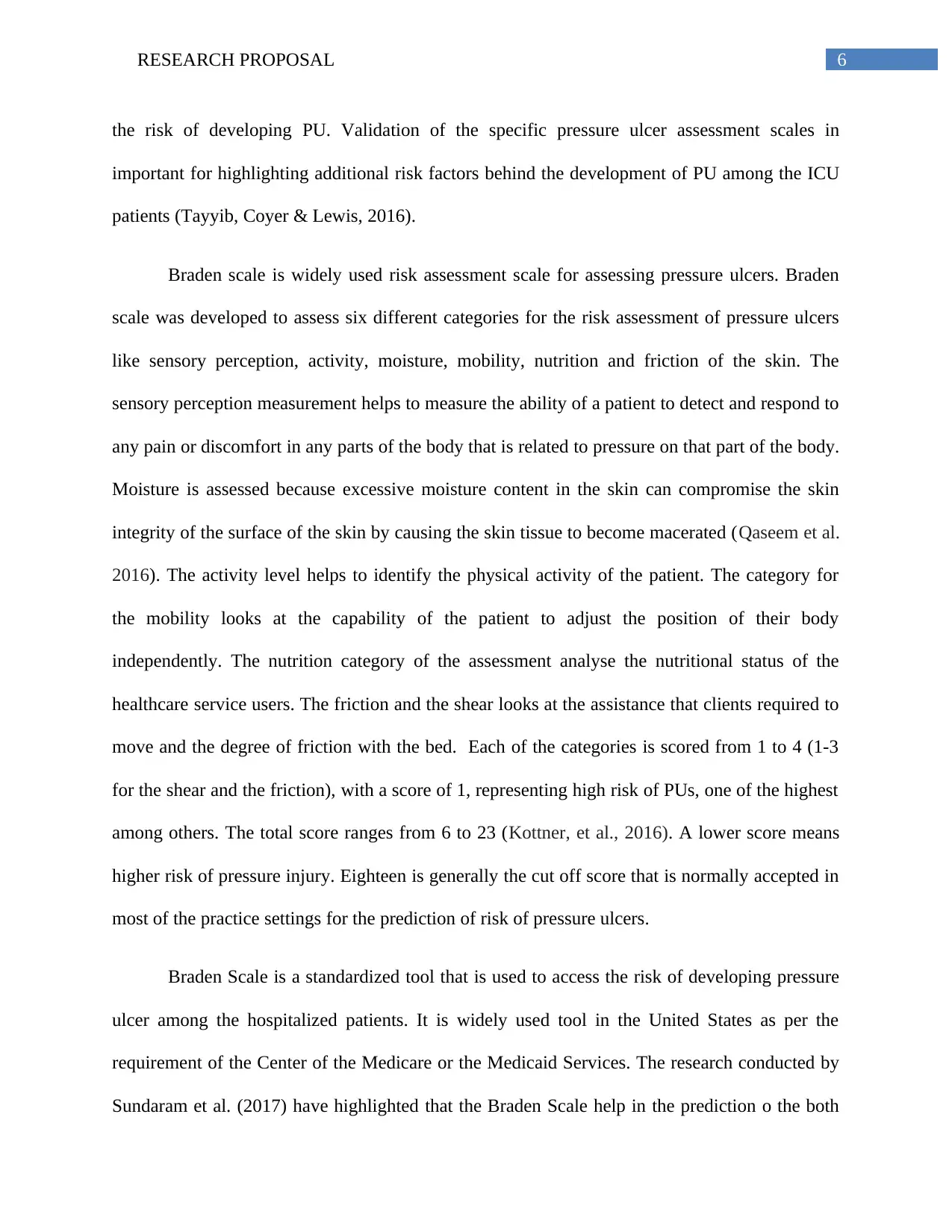
the risk of developing PU. Validation of the specific pressure ulcer assessment scales in
important for highlighting additional risk factors behind the development of PU among the ICU
patients (Tayyib, Coyer & Lewis, 2016).
Braden scale is widely used risk assessment scale for assessing pressure ulcers. Braden
scale was developed to assess six different categories for the risk assessment of pressure ulcers
like sensory perception, activity, moisture, mobility, nutrition and friction of the skin. The
sensory perception measurement helps to measure the ability of a patient to detect and respond to
any pain or discomfort in any parts of the body that is related to pressure on that part of the body.
Moisture is assessed because excessive moisture content in the skin can compromise the skin
integrity of the surface of the skin by causing the skin tissue to become macerated (Qaseem et al.
2016). The activity level helps to identify the physical activity of the patient. The category for
the mobility looks at the capability of the patient to adjust the position of their body
independently. The nutrition category of the assessment analyse the nutritional status of the
healthcare service users. The friction and the shear looks at the assistance that clients required to
move and the degree of friction with the bed. Each of the categories is scored from 1 to 4 (1-3
for the shear and the friction), with a score of 1, representing high risk of PUs, one of the highest
among others. The total score ranges from 6 to 23 (Kottner, et al., 2016). A lower score means
higher risk of pressure injury. Eighteen is generally the cut off score that is normally accepted in
most of the practice settings for the prediction of risk of pressure ulcers.
Braden Scale is a standardized tool that is used to access the risk of developing pressure
ulcer among the hospitalized patients. It is widely used tool in the United States as per the
requirement of the Center of the Medicare or the Medicaid Services. The research conducted by
Sundaram et al. (2017) have highlighted that the Braden Scale help in the prediction o the both
Paraphrase This Document
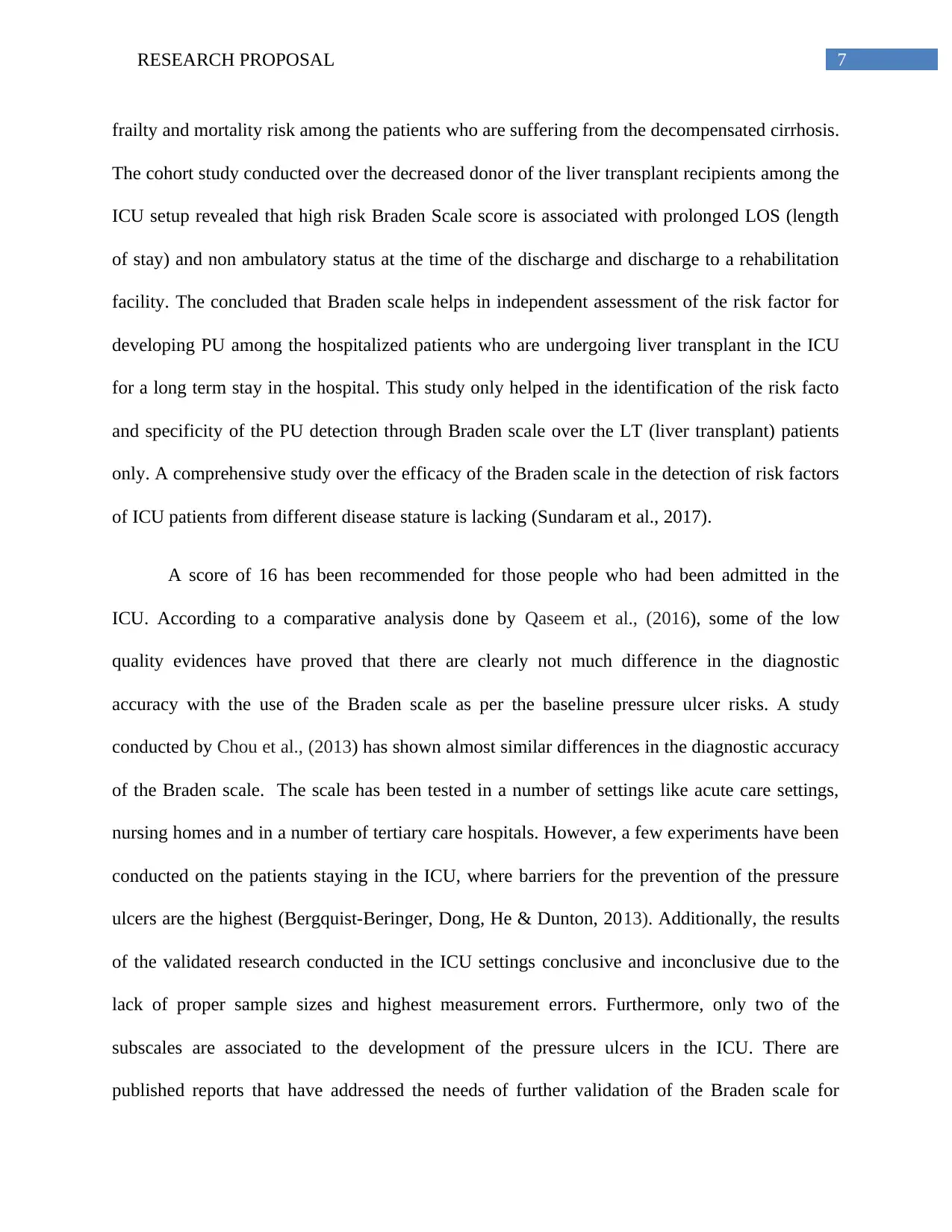
frailty and mortality risk among the patients who are suffering from the decompensated cirrhosis.
The cohort study conducted over the decreased donor of the liver transplant recipients among the
ICU setup revealed that high risk Braden Scale score is associated with prolonged LOS (length
of stay) and non ambulatory status at the time of the discharge and discharge to a rehabilitation
facility. The concluded that Braden scale helps in independent assessment of the risk factor for
developing PU among the hospitalized patients who are undergoing liver transplant in the ICU
for a long term stay in the hospital. This study only helped in the identification of the risk facto
and specificity of the PU detection through Braden scale over the LT (liver transplant) patients
only. A comprehensive study over the efficacy of the Braden scale in the detection of risk factors
of ICU patients from different disease stature is lacking (Sundaram et al., 2017).
A score of 16 has been recommended for those people who had been admitted in the
ICU. According to a comparative analysis done by Qaseem et al., (2016), some of the low
quality evidences have proved that there are clearly not much difference in the diagnostic
accuracy with the use of the Braden scale as per the baseline pressure ulcer risks. A study
conducted by Chou et al., (2013) has shown almost similar differences in the diagnostic accuracy
of the Braden scale. The scale has been tested in a number of settings like acute care settings,
nursing homes and in a number of tertiary care hospitals. However, a few experiments have been
conducted on the patients staying in the ICU, where barriers for the prevention of the pressure
ulcers are the highest (Bergquist-Beringer, Dong, He & Dunton, 2013). Additionally, the results
of the validated research conducted in the ICU settings conclusive and inconclusive due to the
lack of proper sample sizes and highest measurement errors. Furthermore, only two of the
subscales are associated to the development of the pressure ulcers in the ICU. There are
published reports that have addressed the needs of further validation of the Braden scale for
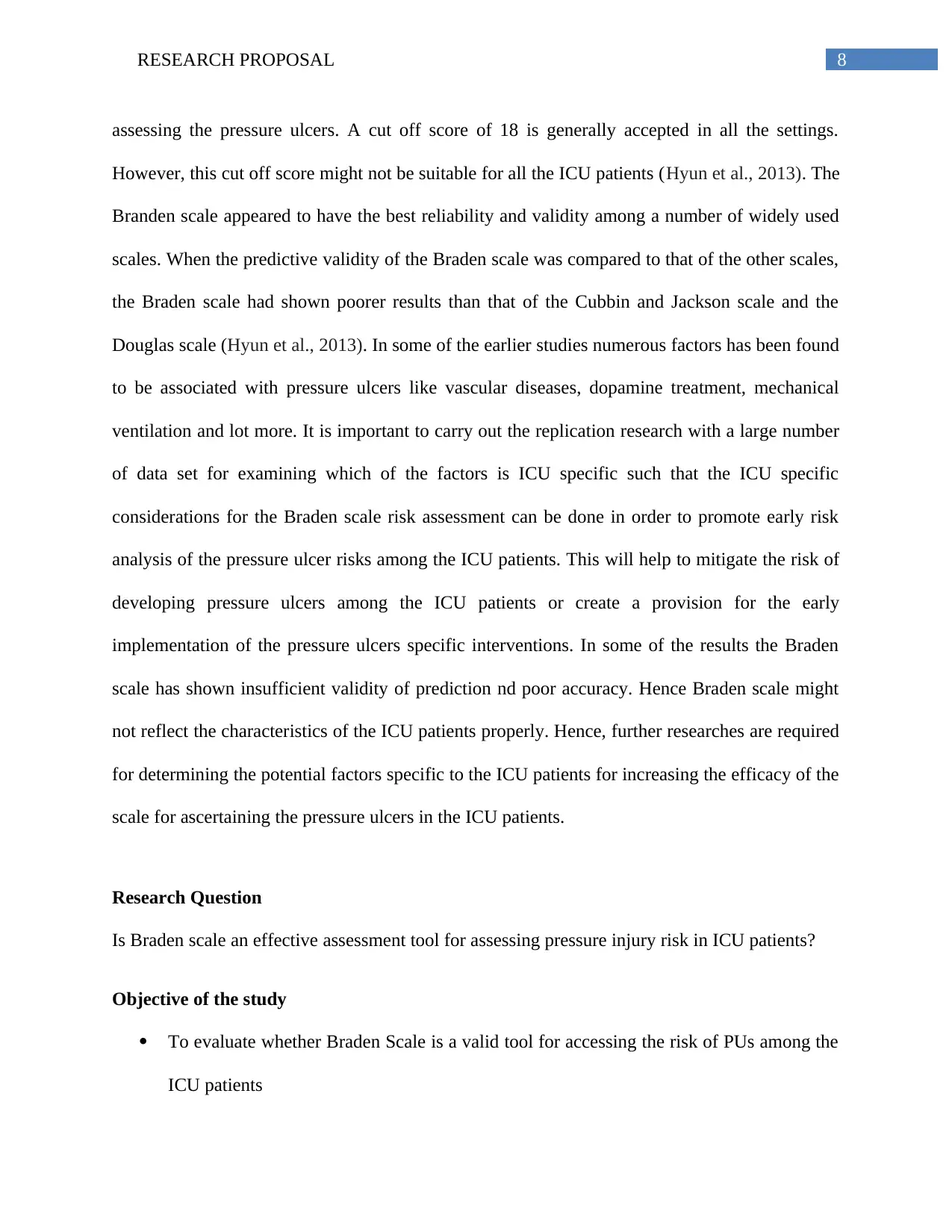
assessing the pressure ulcers. A cut off score of 18 is generally accepted in all the settings.
However, this cut off score might not be suitable for all the ICU patients (Hyun et al., 2013). The
Branden scale appeared to have the best reliability and validity among a number of widely used
scales. When the predictive validity of the Braden scale was compared to that of the other scales,
the Braden scale had shown poorer results than that of the Cubbin and Jackson scale and the
Douglas scale (Hyun et al., 2013). In some of the earlier studies numerous factors has been found
to be associated with pressure ulcers like vascular diseases, dopamine treatment, mechanical
ventilation and lot more. It is important to carry out the replication research with a large number
of data set for examining which of the factors is ICU specific such that the ICU specific
considerations for the Braden scale risk assessment can be done in order to promote early risk
analysis of the pressure ulcer risks among the ICU patients. This will help to mitigate the risk of
developing pressure ulcers among the ICU patients or create a provision for the early
implementation of the pressure ulcers specific interventions. In some of the results the Braden
scale has shown insufficient validity of prediction nd poor accuracy. Hence Braden scale might
not reflect the characteristics of the ICU patients properly. Hence, further researches are required
for determining the potential factors specific to the ICU patients for increasing the efficacy of the
scale for ascertaining the pressure ulcers in the ICU patients.
Research Question
Is Braden scale an effective assessment tool for assessing pressure injury risk in ICU patients?
Objective of the study
To evaluate whether Braden Scale is a valid tool for accessing the risk of PUs among the
ICU patients
⊘ This is a preview!⊘
Do you want full access?
Subscribe today to unlock all pages.

Trusted by 1+ million students worldwide
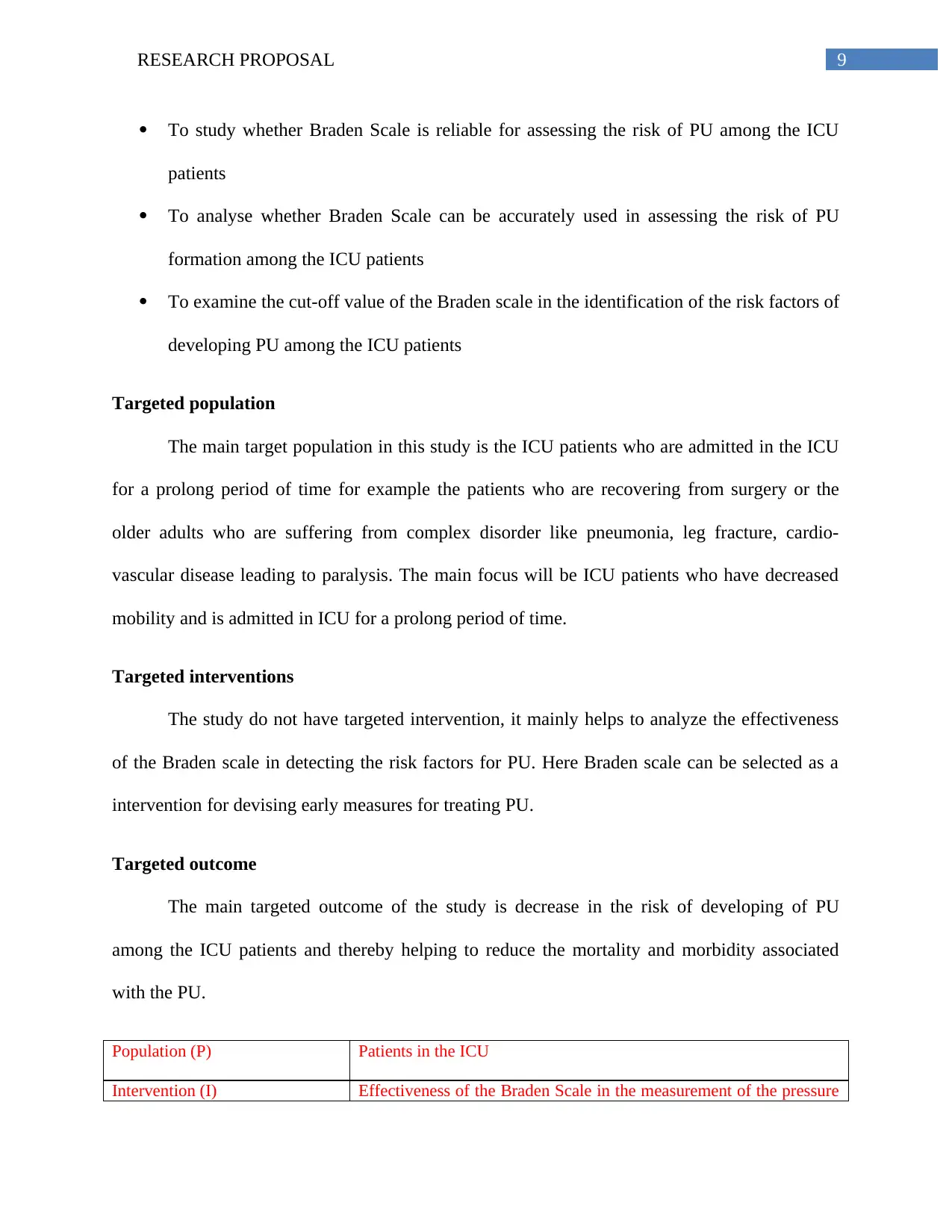
To study whether Braden Scale is reliable for assessing the risk of PU among the ICU
patients
To analyse whether Braden Scale can be accurately used in assessing the risk of PU
formation among the ICU patients
To examine the cut-off value of the Braden scale in the identification of the risk factors of
developing PU among the ICU patients
Targeted population
The main target population in this study is the ICU patients who are admitted in the ICU
for a prolong period of time for example the patients who are recovering from surgery or the
older adults who are suffering from complex disorder like pneumonia, leg fracture, cardio-
vascular disease leading to paralysis. The main focus will be ICU patients who have decreased
mobility and is admitted in ICU for a prolong period of time.
Targeted interventions
The study do not have targeted intervention, it mainly helps to analyze the effectiveness
of the Braden scale in detecting the risk factors for PU. Here Braden scale can be selected as a
intervention for devising early measures for treating PU.
Targeted outcome
The main targeted outcome of the study is decrease in the risk of developing of PU
among the ICU patients and thereby helping to reduce the mortality and morbidity associated
with the PU.
Population (P) Patients in the ICU
Intervention (I) Effectiveness of the Braden Scale in the measurement of the pressure
Paraphrase This Document

ulcer risks
Comparison (C)
Outcomes (O) Early identification of pressure ulcers and implementation of early
interventions
Rationale of the Research question
Intrinsic factors like obesity, presence of nutritional disorder, anaemia, age of the
patients, hypoalbuminemia, complete loss of senses and in ability to move increase the risk of
developing of PUs among the patients admitted in the ICU for long span of time. In order to
prevent the risk of developing of PUs among the ICU patients, the healthcare professionals are
required to identify all the risk factors via thoroughly examining the patients. Various risk
assessment scales have been development and then tested subsequently in order to help the
physicians for the identifications individualized risk factors for PUs. The Braden scale was
development in the year 1987 by Braden ad Bergstrom. It is based on the PU risk factors of
patients who are receiving long-term care. It is most commonly used risk assessment tool (Baris,
Karabacak & Alpar, 2015). The study conducted by Uzun, Aylaz and Karadag (2009) stated that
the reliability co-efficient of Braden scale is 0.95. Baris, Karabacak and Alpar (2015) conducted
another systematic review in order to detect the efficacy, validity and reliability of the Braden
scale for the detection of the PU risk factors among the Turkish patients. The review revealed
that there is restricted evidence of effective risk assessment of PU by the Braden scale.
This research proposal is based on framing of a systematic review that will be done in
order to reach the scientific generalization regarding the assessment of the associated risk factors
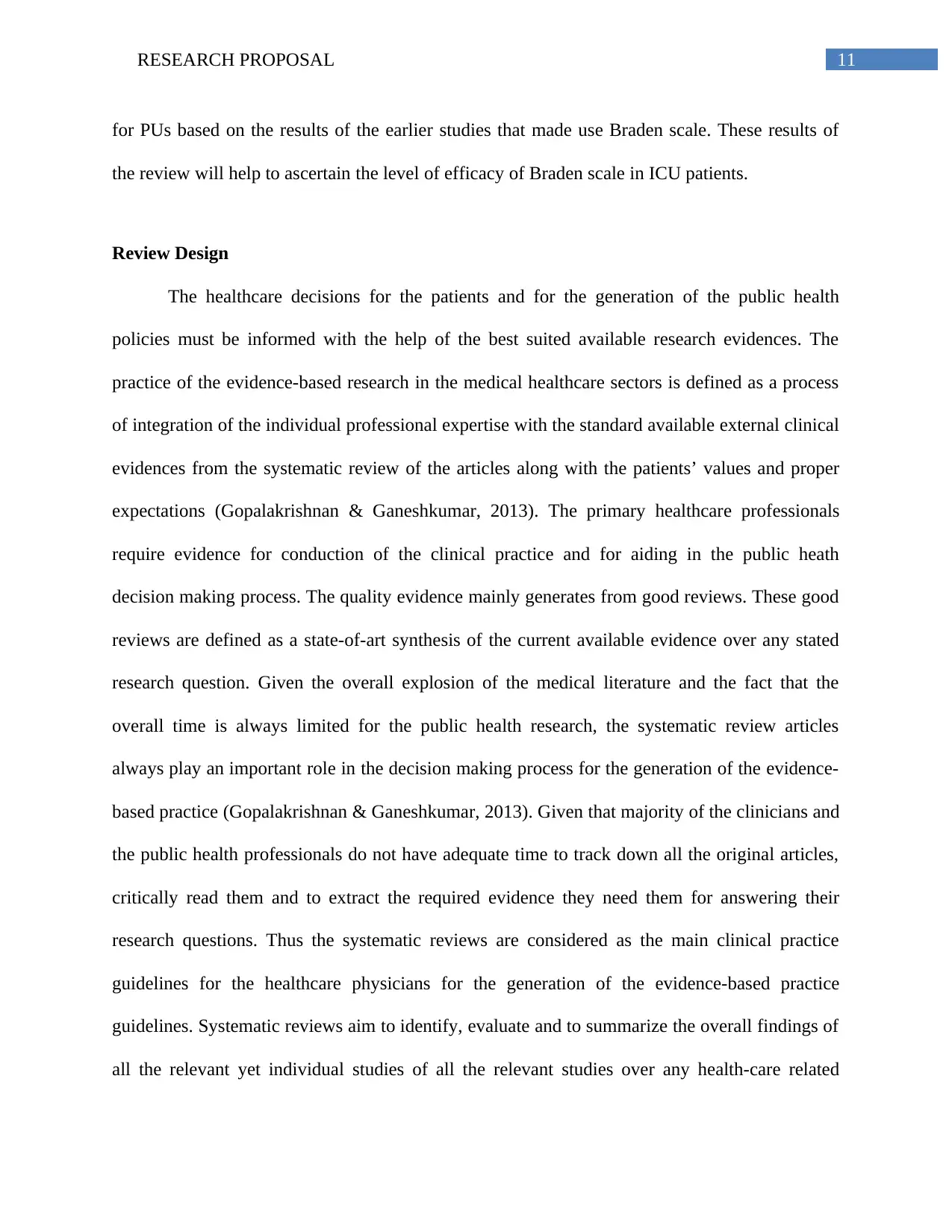
for PUs based on the results of the earlier studies that made use Braden scale. These results of
the review will help to ascertain the level of efficacy of Braden scale in ICU patients.
Review Design
The healthcare decisions for the patients and for the generation of the public health
policies must be informed with the help of the best suited available research evidences. The
practice of the evidence-based research in the medical healthcare sectors is defined as a process
of integration of the individual professional expertise with the standard available external clinical
evidences from the systematic review of the articles along with the patients’ values and proper
expectations (Gopalakrishnan & Ganeshkumar, 2013). The primary healthcare professionals
require evidence for conduction of the clinical practice and for aiding in the public heath
decision making process. The quality evidence mainly generates from good reviews. These good
reviews are defined as a state-of-art synthesis of the current available evidence over any stated
research question. Given the overall explosion of the medical literature and the fact that the
overall time is always limited for the public health research, the systematic review articles
always play an important role in the decision making process for the generation of the evidence-
based practice (Gopalakrishnan & Ganeshkumar, 2013). Given that majority of the clinicians and
the public health professionals do not have adequate time to track down all the original articles,
critically read them and to extract the required evidence they need them for answering their
research questions. Thus the systematic reviews are considered as the main clinical practice
guidelines for the healthcare physicians for the generation of the evidence-based practice
guidelines. Systematic reviews aim to identify, evaluate and to summarize the overall findings of
all the relevant yet individual studies of all the relevant studies over any health-care related
⊘ This is a preview!⊘
Do you want full access?
Subscribe today to unlock all pages.

Trusted by 1+ million students worldwide
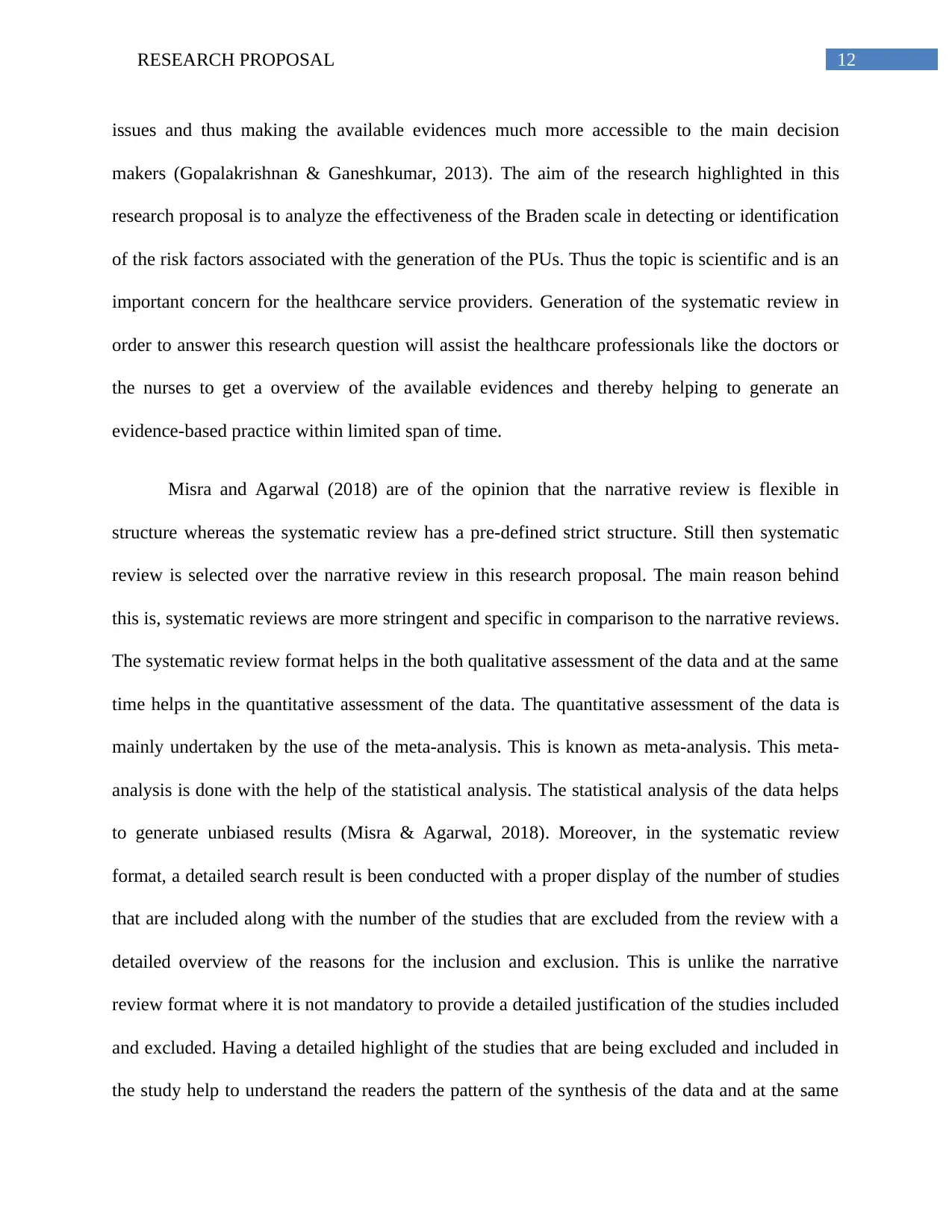
issues and thus making the available evidences much more accessible to the main decision
makers (Gopalakrishnan & Ganeshkumar, 2013). The aim of the research highlighted in this
research proposal is to analyze the effectiveness of the Braden scale in detecting or identification
of the risk factors associated with the generation of the PUs. Thus the topic is scientific and is an
important concern for the healthcare service providers. Generation of the systematic review in
order to answer this research question will assist the healthcare professionals like the doctors or
the nurses to get a overview of the available evidences and thereby helping to generate an
evidence-based practice within limited span of time.
Misra and Agarwal (2018) are of the opinion that the narrative review is flexible in
structure whereas the systematic review has a pre-defined strict structure. Still then systematic
review is selected over the narrative review in this research proposal. The main reason behind
this is, systematic reviews are more stringent and specific in comparison to the narrative reviews.
The systematic review format helps in the both qualitative assessment of the data and at the same
time helps in the quantitative assessment of the data. The quantitative assessment of the data is
mainly undertaken by the use of the meta-analysis. This is known as meta-analysis. This meta-
analysis is done with the help of the statistical analysis. The statistical analysis of the data helps
to generate unbiased results (Misra & Agarwal, 2018). Moreover, in the systematic review
format, a detailed search result is been conducted with a proper display of the number of studies
that are included along with the number of the studies that are excluded from the review with a
detailed overview of the reasons for the inclusion and exclusion. This is unlike the narrative
review format where it is not mandatory to provide a detailed justification of the studies included
and excluded. Having a detailed highlight of the studies that are being excluded and included in
the study help to understand the readers the pattern of the synthesis of the data and at the same
Paraphrase This Document
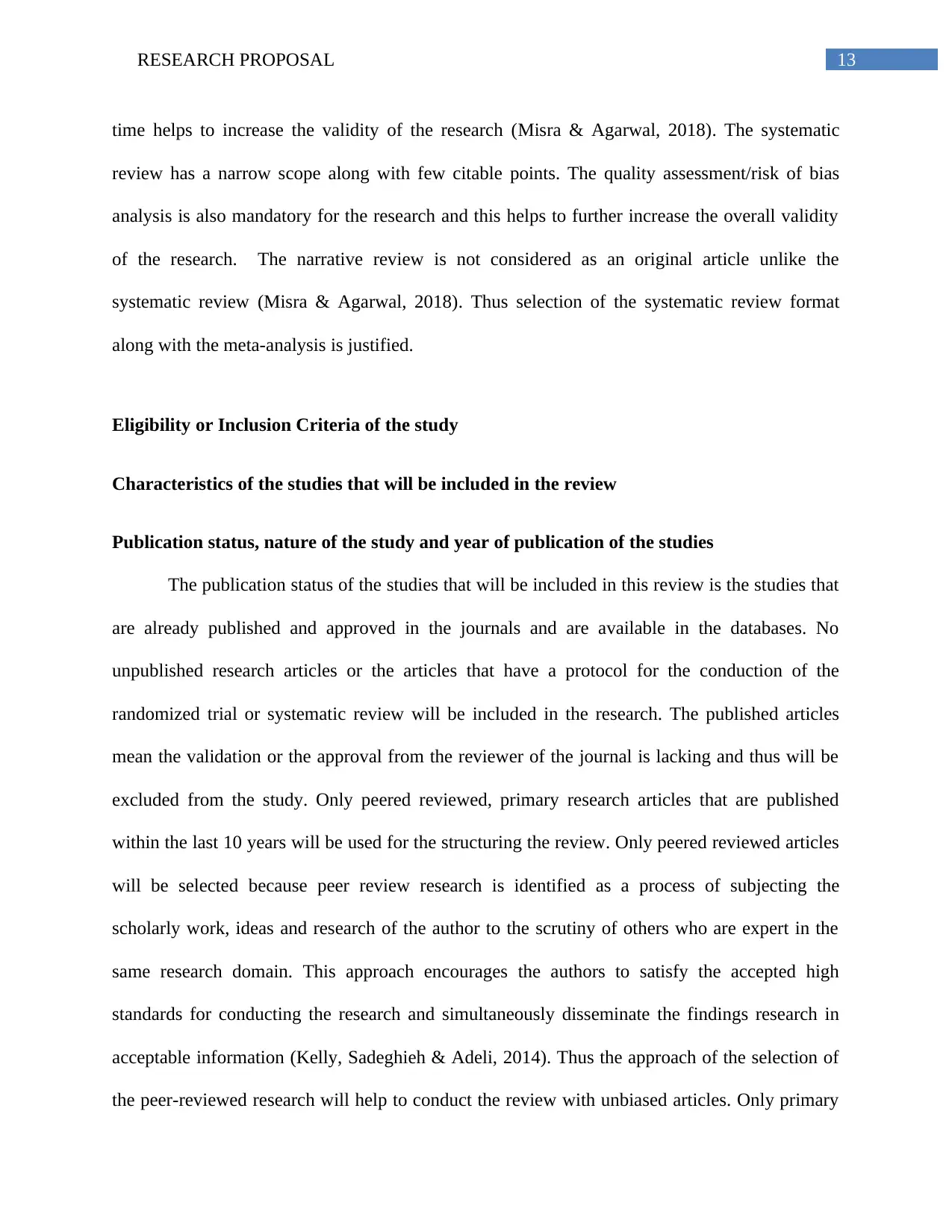
time helps to increase the validity of the research (Misra & Agarwal, 2018). The systematic
review has a narrow scope along with few citable points. The quality assessment/risk of bias
analysis is also mandatory for the research and this helps to further increase the overall validity
of the research. The narrative review is not considered as an original article unlike the
systematic review (Misra & Agarwal, 2018). Thus selection of the systematic review format
along with the meta-analysis is justified.
Eligibility or Inclusion Criteria of the study
Characteristics of the studies that will be included in the review
Publication status, nature of the study and year of publication of the studies
The publication status of the studies that will be included in this review is the studies that
are already published and approved in the journals and are available in the databases. No
unpublished research articles or the articles that have a protocol for the conduction of the
randomized trial or systematic review will be included in the research. The published articles
mean the validation or the approval from the reviewer of the journal is lacking and thus will be
excluded from the study. Only peered reviewed, primary research articles that are published
within the last 10 years will be used for the structuring the review. Only peered reviewed articles
will be selected because peer review research is identified as a process of subjecting the
scholarly work, ideas and research of the author to the scrutiny of others who are expert in the
same research domain. This approach encourages the authors to satisfy the accepted high
standards for conducting the research and simultaneously disseminate the findings research in
acceptable information (Kelly, Sadeghieh & Adeli, 2014). Thus the approach of the selection of
the peer-reviewed research will help to conduct the review with unbiased articles. Only primary
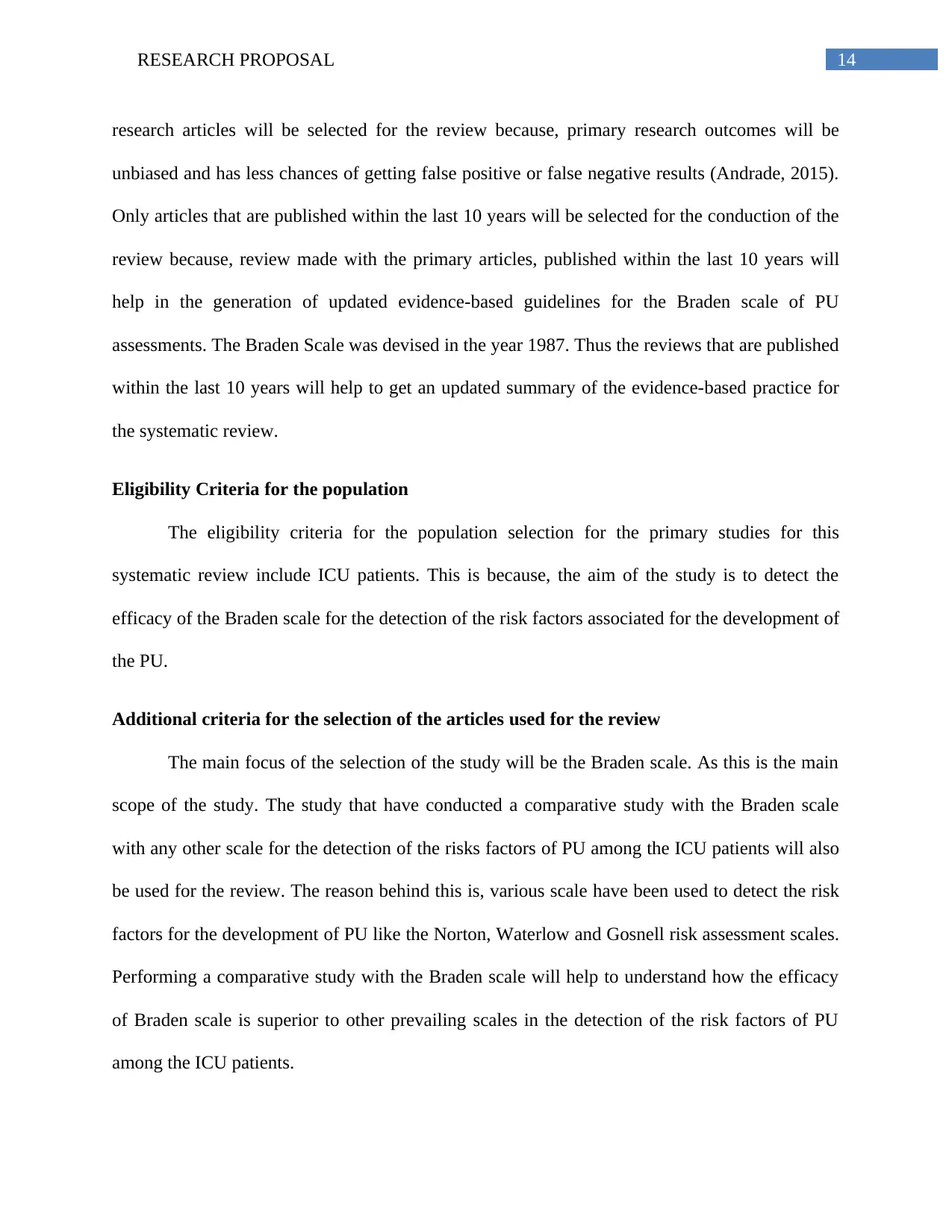
research articles will be selected for the review because, primary research outcomes will be
unbiased and has less chances of getting false positive or false negative results (Andrade, 2015).
Only articles that are published within the last 10 years will be selected for the conduction of the
review because, review made with the primary articles, published within the last 10 years will
help in the generation of updated evidence-based guidelines for the Braden scale of PU
assessments. The Braden Scale was devised in the year 1987. Thus the reviews that are published
within the last 10 years will help to get an updated summary of the evidence-based practice for
the systematic review.
Eligibility Criteria for the population
The eligibility criteria for the population selection for the primary studies for this
systematic review include ICU patients. This is because, the aim of the study is to detect the
efficacy of the Braden scale for the detection of the risk factors associated for the development of
the PU.
Additional criteria for the selection of the articles used for the review
The main focus of the selection of the study will be the Braden scale. As this is the main
scope of the study. The study that have conducted a comparative study with the Braden scale
with any other scale for the detection of the risks factors of PU among the ICU patients will also
be used for the review. The reason behind this is, various scale have been used to detect the risk
factors for the development of PU like the Norton, Waterlow and Gosnell risk assessment scales.
Performing a comparative study with the Braden scale will help to understand how the efficacy
of Braden scale is superior to other prevailing scales in the detection of the risk factors of PU
among the ICU patients.
⊘ This is a preview!⊘
Do you want full access?
Subscribe today to unlock all pages.

Trusted by 1+ million students worldwide
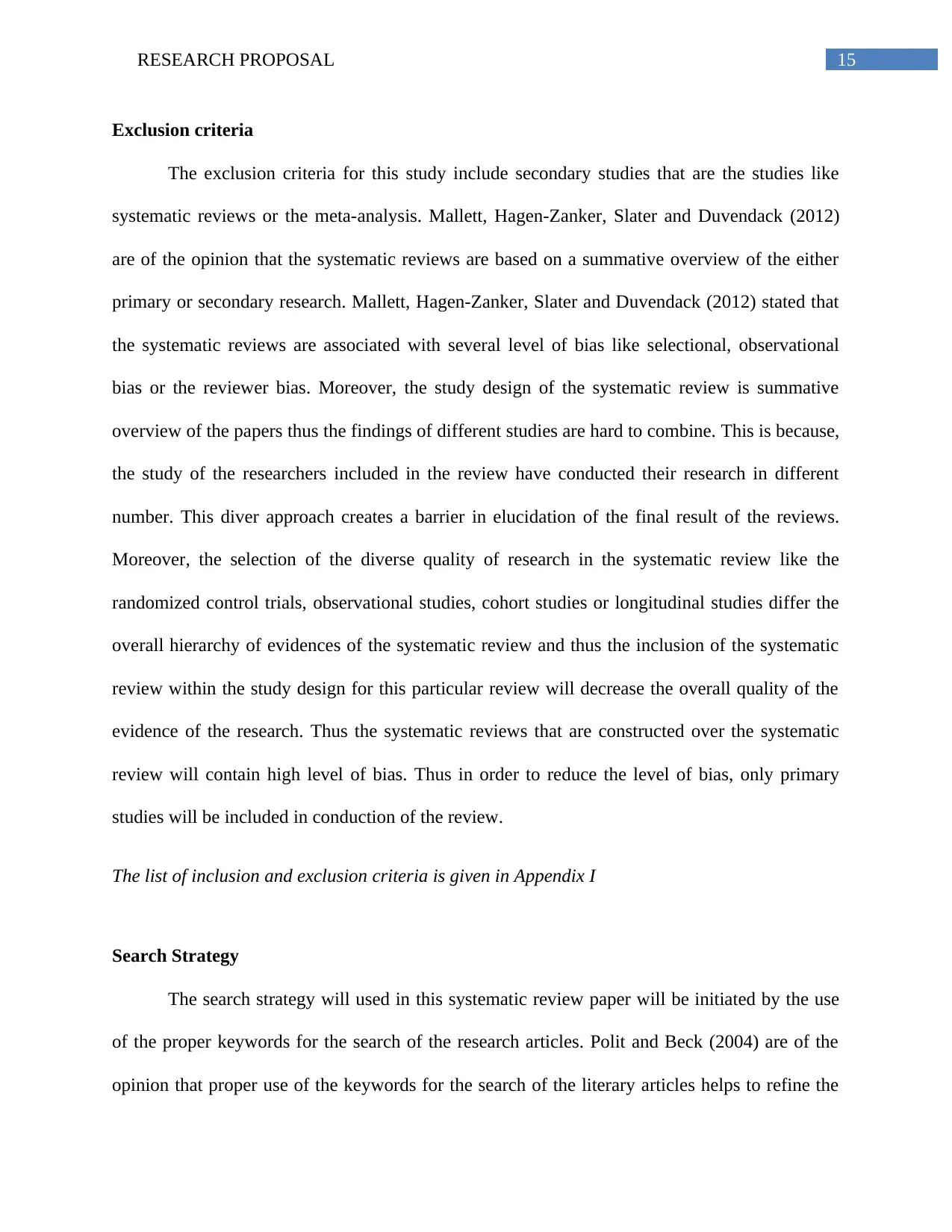
Exclusion criteria
The exclusion criteria for this study include secondary studies that are the studies like
systematic reviews or the meta-analysis. Mallett, Hagen-Zanker, Slater and Duvendack (2012)
are of the opinion that the systematic reviews are based on a summative overview of the either
primary or secondary research. Mallett, Hagen-Zanker, Slater and Duvendack (2012) stated that
the systematic reviews are associated with several level of bias like selectional, observational
bias or the reviewer bias. Moreover, the study design of the systematic review is summative
overview of the papers thus the findings of different studies are hard to combine. This is because,
the study of the researchers included in the review have conducted their research in different
number. This diver approach creates a barrier in elucidation of the final result of the reviews.
Moreover, the selection of the diverse quality of research in the systematic review like the
randomized control trials, observational studies, cohort studies or longitudinal studies differ the
overall hierarchy of evidences of the systematic review and thus the inclusion of the systematic
review within the study design for this particular review will decrease the overall quality of the
evidence of the research. Thus the systematic reviews that are constructed over the systematic
review will contain high level of bias. Thus in order to reduce the level of bias, only primary
studies will be included in conduction of the review.
The list of inclusion and exclusion criteria is given in Appendix I
Search Strategy
The search strategy will used in this systematic review paper will be initiated by the use
of the proper keywords for the search of the research articles. Polit and Beck (2004) are of the
opinion that proper use of the keywords for the search of the literary articles helps to refine the
Paraphrase This Document
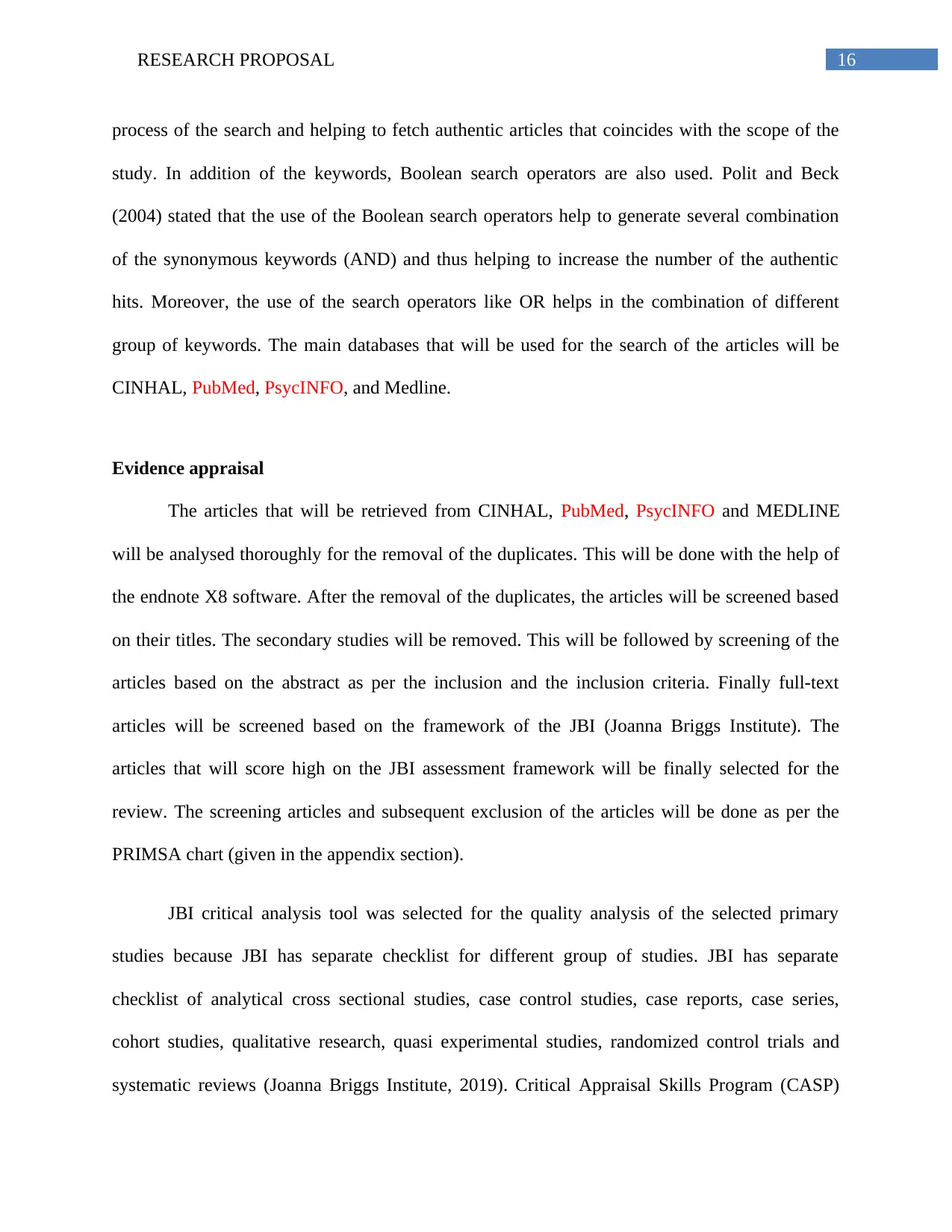
process of the search and helping to fetch authentic articles that coincides with the scope of the
study. In addition of the keywords, Boolean search operators are also used. Polit and Beck
(2004) stated that the use of the Boolean search operators help to generate several combination
of the synonymous keywords (AND) and thus helping to increase the number of the authentic
hits. Moreover, the use of the search operators like OR helps in the combination of different
group of keywords. The main databases that will be used for the search of the articles will be
CINHAL, PubMed, PsycINFO, and Medline.
Evidence appraisal
The articles that will be retrieved from CINHAL, PubMed, PsycINFO and MEDLINE
will be analysed thoroughly for the removal of the duplicates. This will be done with the help of
the endnote X8 software. After the removal of the duplicates, the articles will be screened based
on their titles. The secondary studies will be removed. This will be followed by screening of the
articles based on the abstract as per the inclusion and the inclusion criteria. Finally full-text
articles will be screened based on the framework of the JBI (Joanna Briggs Institute). The
articles that will score high on the JBI assessment framework will be finally selected for the
review. The screening articles and subsequent exclusion of the articles will be done as per the
PRIMSA chart (given in the appendix section).
JBI critical analysis tool was selected for the quality analysis of the selected primary
studies because JBI has separate checklist for different group of studies. JBI has separate
checklist of analytical cross sectional studies, case control studies, case reports, case series,
cohort studies, qualitative research, quasi experimental studies, randomized control trials and
systematic reviews (Joanna Briggs Institute, 2019). Critical Appraisal Skills Program (CASP)

tool is not as diverse as JBI. CASP critical analysis framework is limited to qualitative checklist,
randomized controlled trials, case control studies and cohort studies. Due to the diversity of the
JBI tool, JBI is selected over CASP (Munn, Moola, Riitano & Lisy, 2014).
Analysis
The qualitative analysis of the data will be done based on the content analysis. The meta-
analysis (quantitative analysis), mean, standard deviations and the sample sizes along with the
effectivesness of the Braden scale will be will be collated the papers. When the information will
be missing, the authors will be contacted and even after this if the information could not be
retrieved then the paper will be discarded. The statistical procedure for the meta-analysis will
follow numerous steps based on the Clark-Carter’s guidelines (Phan, Tian, Cao, Black & Yan,
2015). The effect sizes for all the studies will be computed and then converted to a common
statistics r. The r values will be then converted to Z scores by the use of Fishers’ Z
transformation and then will be used to calculate the weighted mean for all the studies and the
confidence interval. In order to test the significance, Z scores will be calculated for each study
and then it will be used to calculate the combined probability. Checks for the heterogeneity of
the effect size will be done in order to reduce the publication bias (Phan, Tian, Cao, Black &
Yan, 2015).
Rigor
In order to increase the rigor of the study, the author will take active effort for the
reduction of the assessment. For the reduction of the assessment bias, the following items will be
taken under consideration: adequate sequence generation, allocation concealment, incomplete
outcome of the study, reporting of the selective outcome of the study and process of data
⊘ This is a preview!⊘
Do you want full access?
Subscribe today to unlock all pages.

Trusted by 1+ million students worldwide

reporting. For the assessment of reporting bias, the author will avoid reporting bias by including
studies and not articles (Sterne et al., 2016). If more than one article were found to report same
results then consolidated data will be used. The publication bias will be analyzed with the help of
the funnel plots. To analyze the effect risk bias on the pooled results, author will use sensitivity
analysis in which studies with high risks of bias will be excluded (Sterne et al., 2016).
Ethical Consideration
As the studies that will be included in the review will be accessed from the databases
open to the research scholars who have the access to those databases, no ethical approval was
deemed necessary. The research papers which are not available full-text in the selected databases
: CINHAL and Medline, permission will be requested from the designated first author in order to
have access of his or her full-text journal articles through official mail. The authors who will fail
to respond back through mail or will deny to give permission for the full-text access, those paper
will not be included in the review. This will help to abide by ethical principle of autonomy.
Dissemination of the findings
The findings of each of the paper will be illustrated in a tabular format.
Name of
the
authors
Aim of
the study
Type of
study
Sample
size
Findings Statistical
significance
Conclusion Unexplained
outcomes
Paraphrase This Document
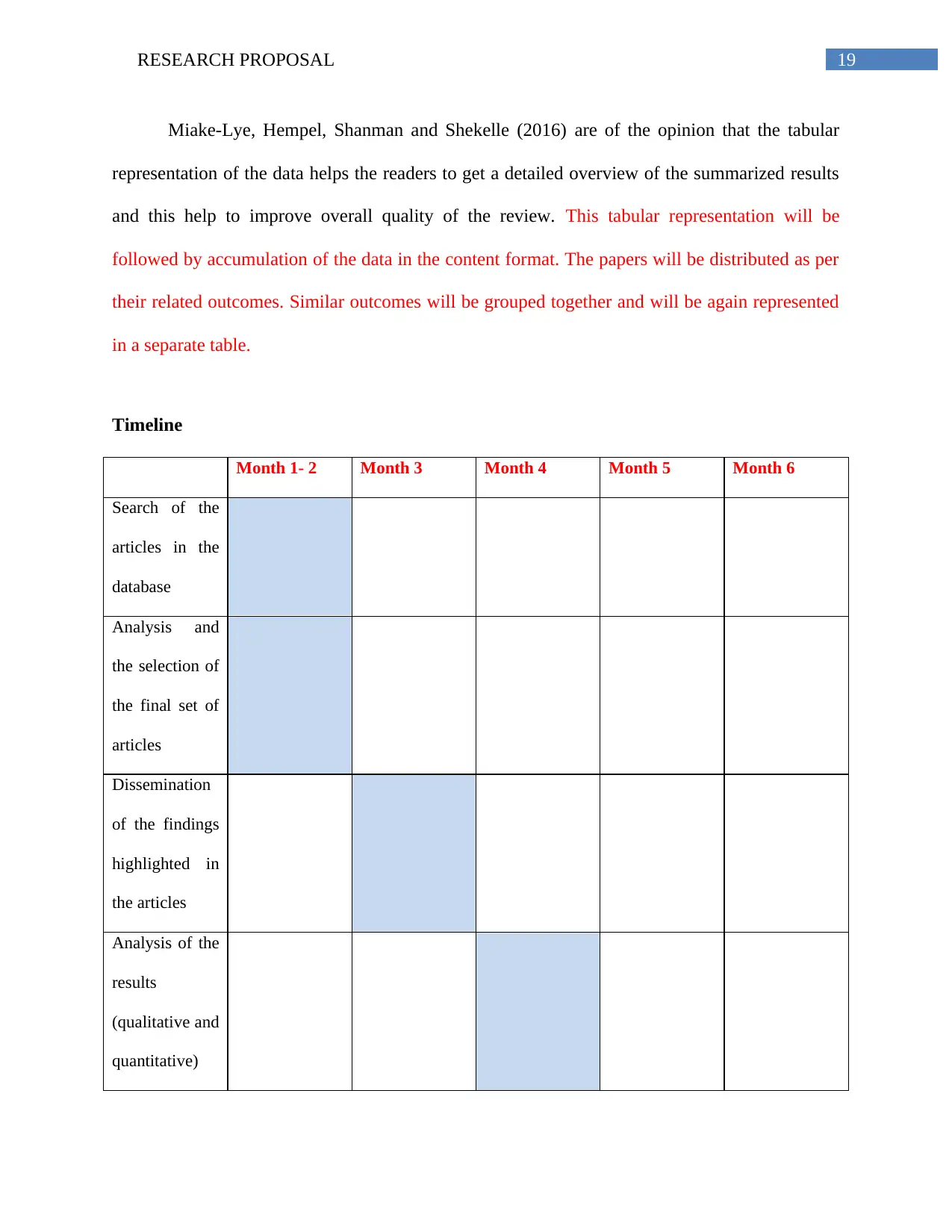
Miake-Lye, Hempel, Shanman and Shekelle (2016) are of the opinion that the tabular
representation of the data helps the readers to get a detailed overview of the summarized results
and this help to improve overall quality of the review. This tabular representation will be
followed by accumulation of the data in the content format. The papers will be distributed as per
their related outcomes. Similar outcomes will be grouped together and will be again represented
in a separate table.
Timeline
Month 1- 2 Month 3 Month 4 Month 5 Month 6
Search of the
articles in the
database
Analysis and
the selection of
the final set of
articles
Dissemination
of the findings
highlighted in
the articles
Analysis of the
results
(qualitative and
quantitative)

Stating the
final results
Writing the
final report
⊘ This is a preview!⊘
Do you want full access?
Subscribe today to unlock all pages.

Trusted by 1+ million students worldwide
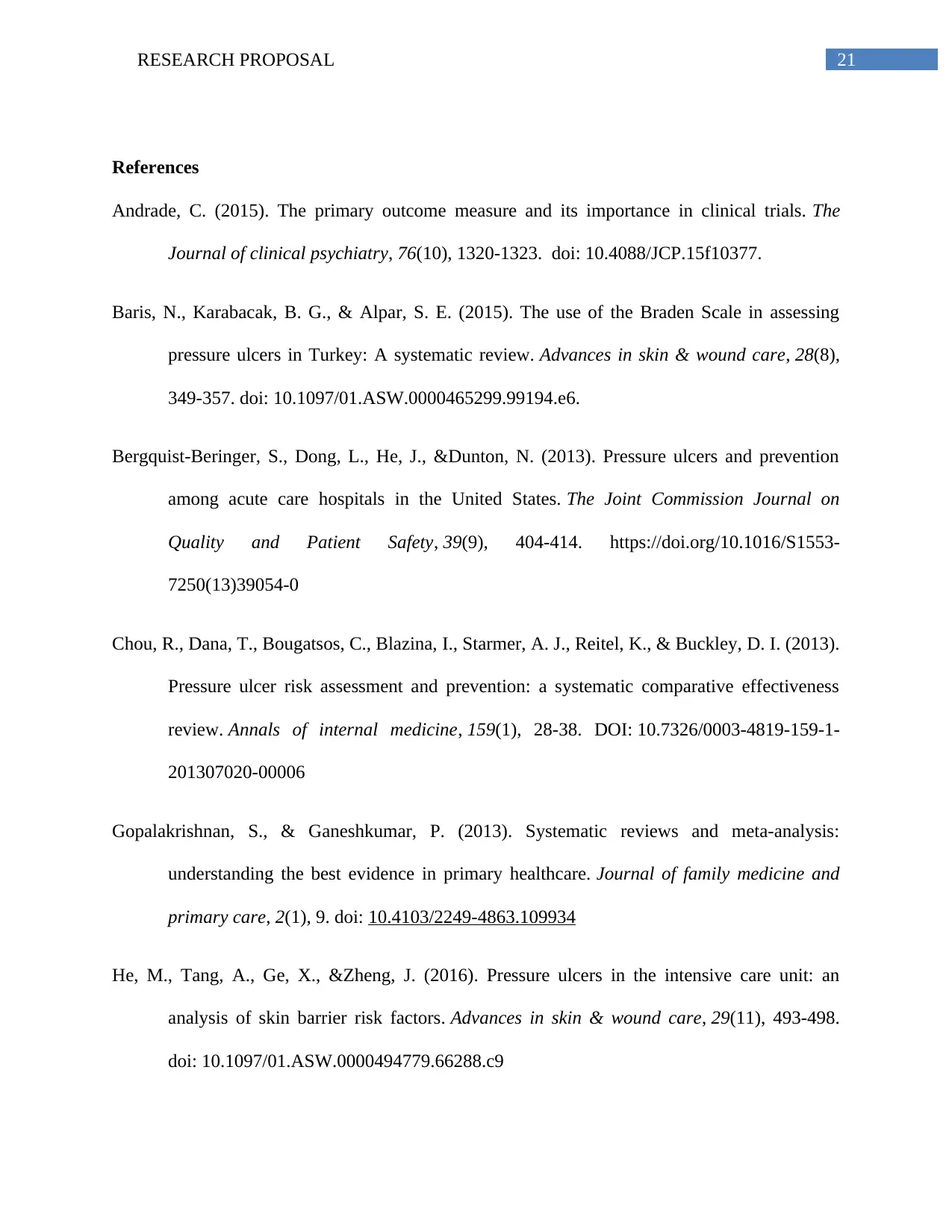
References
Andrade, C. (2015). The primary outcome measure and its importance in clinical trials. The
Journal of clinical psychiatry, 76(10), 1320-1323. doi: 10.4088/JCP.15f10377.
Baris, N., Karabacak, B. G., & Alpar, S. E. (2015). The use of the Braden Scale in assessing
pressure ulcers in Turkey: A systematic review. Advances in skin & wound care, 28(8),
349-357. doi: 10.1097/01.ASW.0000465299.99194.e6.
Bergquist-Beringer, S., Dong, L., He, J., &Dunton, N. (2013). Pressure ulcers and prevention
among acute care hospitals in the United States. The Joint Commission Journal on
Quality and Patient Safety, 39(9), 404-414. https://doi.org/10.1016/S1553-
7250(13)39054-0
Chou, R., Dana, T., Bougatsos, C., Blazina, I., Starmer, A. J., Reitel, K., & Buckley, D. I. (2013).
Pressure ulcer risk assessment and prevention: a systematic comparative effectiveness
review. Annals of internal medicine, 159(1), 28-38. DOI: 10.7326/0003-4819-159-1-
201307020-00006
Gopalakrishnan, S., & Ganeshkumar, P. (2013). Systematic reviews and meta-analysis:
understanding the best evidence in primary healthcare. Journal of family medicine and
primary care, 2(1), 9. doi: 10.4103/2249-4863.109934
He, M., Tang, A., Ge, X., &Zheng, J. (2016). Pressure ulcers in the intensive care unit: an
analysis of skin barrier risk factors. Advances in skin & wound care, 29(11), 493-498.
doi: 10.1097/01.ASW.0000494779.66288.c9
Paraphrase This Document
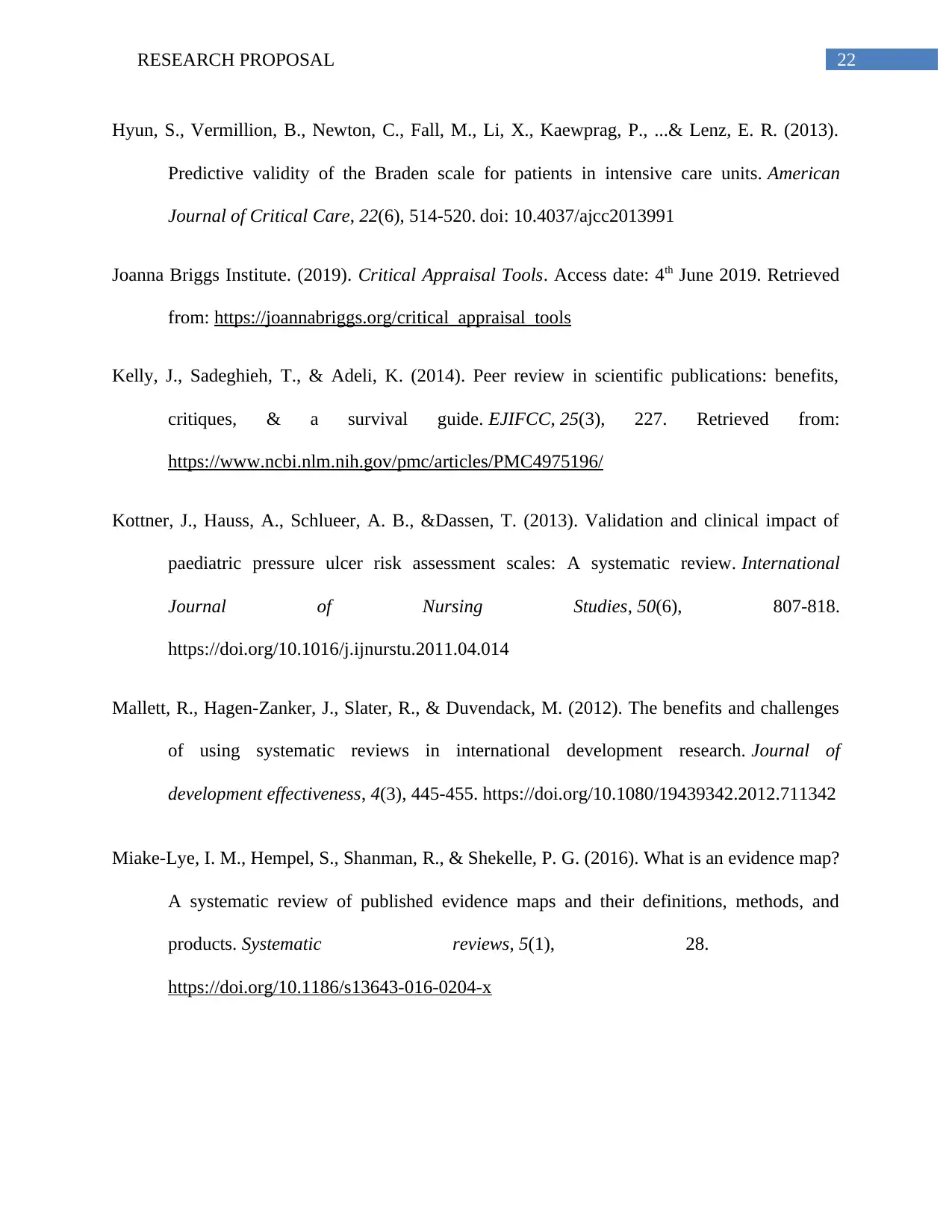
Hyun, S., Vermillion, B., Newton, C., Fall, M., Li, X., Kaewprag, P., ...& Lenz, E. R. (2013).
Predictive validity of the Braden scale for patients in intensive care units. American
Journal of Critical Care, 22(6), 514-520. doi: 10.4037/ajcc2013991
Joanna Briggs Institute. (2019). Critical Appraisal Tools. Access date: 4th June 2019. Retrieved
from: https://joannabriggs.org/critical_appraisal_tools
Kelly, J., Sadeghieh, T., & Adeli, K. (2014). Peer review in scientific publications: benefits,
critiques, & a survival guide. EJIFCC, 25(3), 227. Retrieved from:
https://www.ncbi.nlm.nih.gov/pmc/articles/PMC4975196/
Kottner, J., Hauss, A., Schlueer, A. B., &Dassen, T. (2013). Validation and clinical impact of
paediatric pressure ulcer risk assessment scales: A systematic review. International
Journal of Nursing Studies, 50(6), 807-818.
https://doi.org/10.1016/j.ijnurstu.2011.04.014
Mallett, R., Hagen-Zanker, J., Slater, R., & Duvendack, M. (2012). The benefits and challenges
of using systematic reviews in international development research. Journal of
development effectiveness, 4(3), 445-455. https://doi.org/10.1080/19439342.2012.711342
Miake-Lye, I. M., Hempel, S., Shanman, R., & Shekelle, P. G. (2016). What is an evidence map?
A systematic review of published evidence maps and their definitions, methods, and
products. Systematic reviews, 5(1), 28.
https://doi.org/10.1186/s13643-016-0204-x
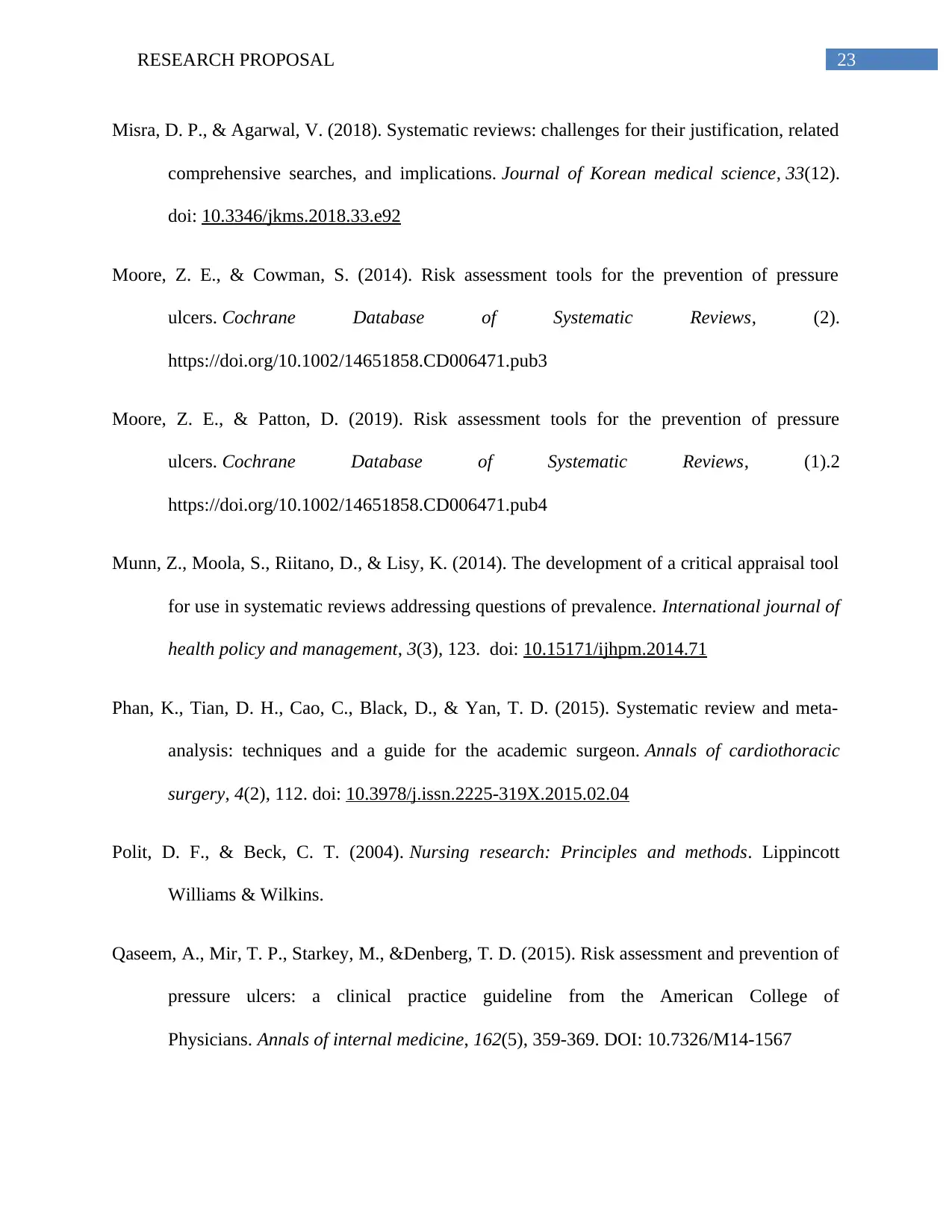
Misra, D. P., & Agarwal, V. (2018). Systematic reviews: challenges for their justification, related
comprehensive searches, and implications. Journal of Korean medical science, 33(12).
doi: 10.3346/jkms.2018.33.e92
Moore, Z. E., & Cowman, S. (2014). Risk assessment tools for the prevention of pressure
ulcers. Cochrane Database of Systematic Reviews, (2).
https://doi.org/10.1002/14651858.CD006471.pub3
Moore, Z. E., & Patton, D. (2019). Risk assessment tools for the prevention of pressure
ulcers. Cochrane Database of Systematic Reviews, (1).2
https://doi.org/10.1002/14651858.CD006471.pub4
Munn, Z., Moola, S., Riitano, D., & Lisy, K. (2014). The development of a critical appraisal tool
for use in systematic reviews addressing questions of prevalence. International journal of
health policy and management, 3(3), 123. doi: 10.15171/ijhpm.2014.71
Phan, K., Tian, D. H., Cao, C., Black, D., & Yan, T. D. (2015). Systematic review and meta-
analysis: techniques and a guide for the academic surgeon. Annals of cardiothoracic
surgery, 4(2), 112. doi: 10.3978/j.issn.2225-319X.2015.02.04
Polit, D. F., & Beck, C. T. (2004). Nursing research: Principles and methods. Lippincott
Williams & Wilkins.
Qaseem, A., Mir, T. P., Starkey, M., &Denberg, T. D. (2015). Risk assessment and prevention of
pressure ulcers: a clinical practice guideline from the American College of
Physicians. Annals of internal medicine, 162(5), 359-369. DOI: 10.7326/M14-1567
⊘ This is a preview!⊘
Do you want full access?
Subscribe today to unlock all pages.

Trusted by 1+ million students worldwide
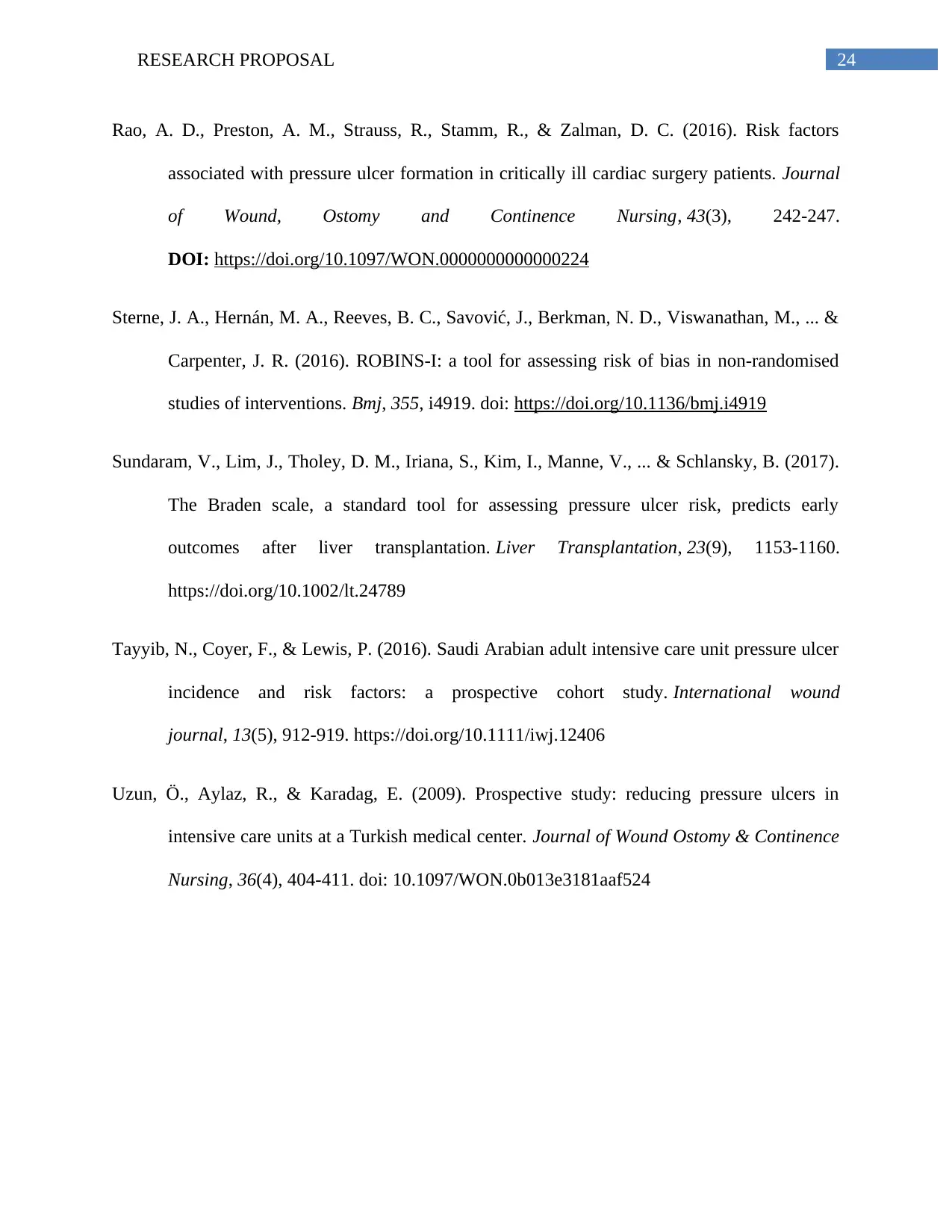
Rao, A. D., Preston, A. M., Strauss, R., Stamm, R., & Zalman, D. C. (2016). Risk factors
associated with pressure ulcer formation in critically ill cardiac surgery patients. Journal
of Wound, Ostomy and Continence Nursing, 43(3), 242-247.
DOI: https://doi.org/10.1097/WON.0000000000000224
Sterne, J. A., Hernán, M. A., Reeves, B. C., Savović, J., Berkman, N. D., Viswanathan, M., ... &
Carpenter, J. R. (2016). ROBINS-I: a tool for assessing risk of bias in non-randomised
studies of interventions. Bmj, 355, i4919. doi: https://doi.org/10.1136/bmj.i4919
Sundaram, V., Lim, J., Tholey, D. M., Iriana, S., Kim, I., Manne, V., ... & Schlansky, B. (2017).
The Braden scale, a standard tool for assessing pressure ulcer risk, predicts early
outcomes after liver transplantation. Liver Transplantation, 23(9), 1153-1160.
https://doi.org/10.1002/lt.24789
Tayyib, N., Coyer, F., & Lewis, P. (2016). Saudi Arabian adult intensive care unit pressure ulcer
incidence and risk factors: a prospective cohort study. International wound
journal, 13(5), 912-919. https://doi.org/10.1111/iwj.12406
Uzun, Ö., Aylaz, R., & Karadag, E. (2009). Prospective study: reducing pressure ulcers in
intensive care units at a Turkish medical center. Journal of Wound Ostomy & Continence
Nursing, 36(4), 404-411. doi: 10.1097/WON.0b013e3181aaf524
Paraphrase This Document
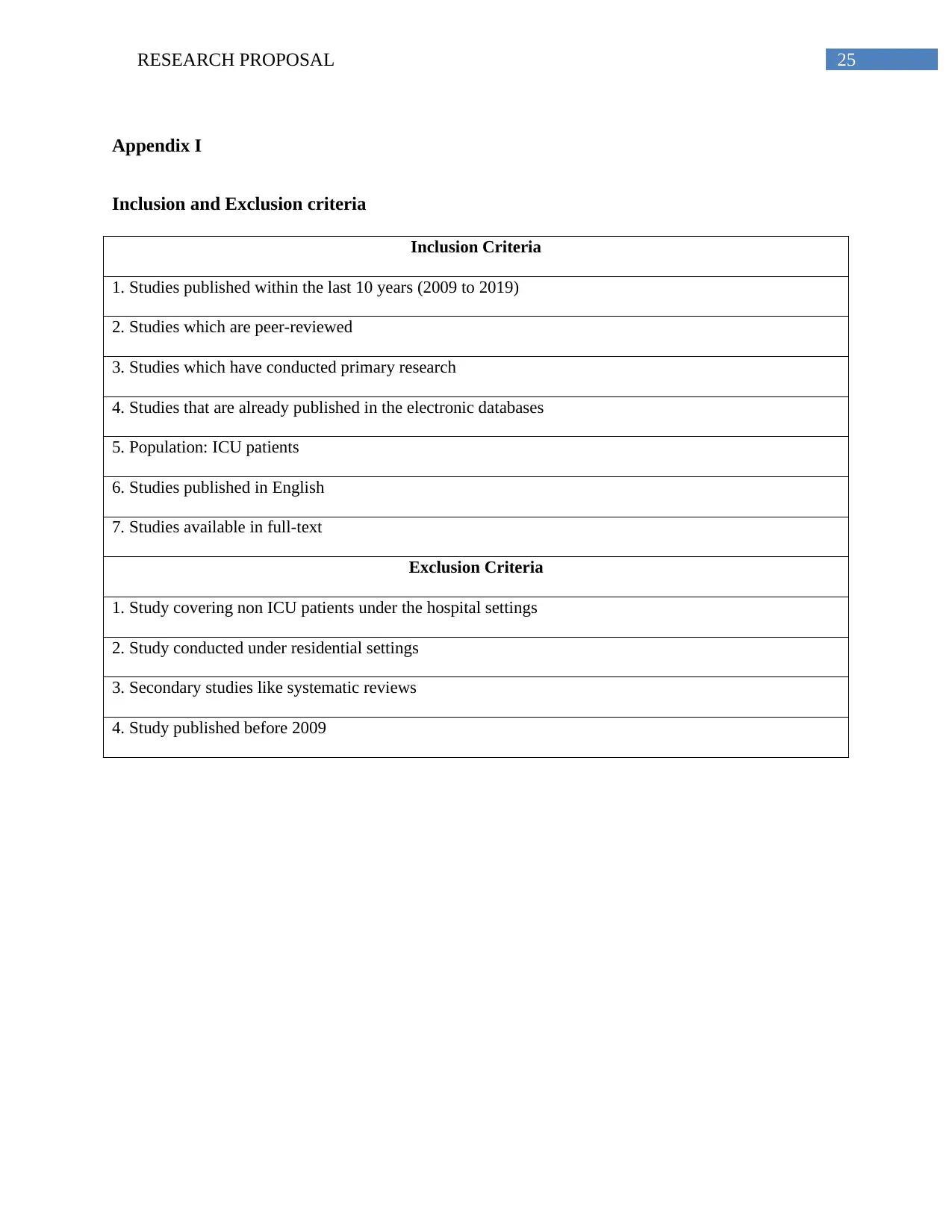
Appendix I
Inclusion and Exclusion criteria
Inclusion Criteria
1. Studies published within the last 10 years (2009 to 2019)
2. Studies which are peer-reviewed
3. Studies which have conducted primary research
4. Studies that are already published in the electronic databases
5. Population: ICU patients
6. Studies published in English
7. Studies available in full-text
Exclusion Criteria
1. Study covering non ICU patients under the hospital settings
2. Study conducted under residential settings
3. Secondary studies like systematic reviews
4. Study published before 2009
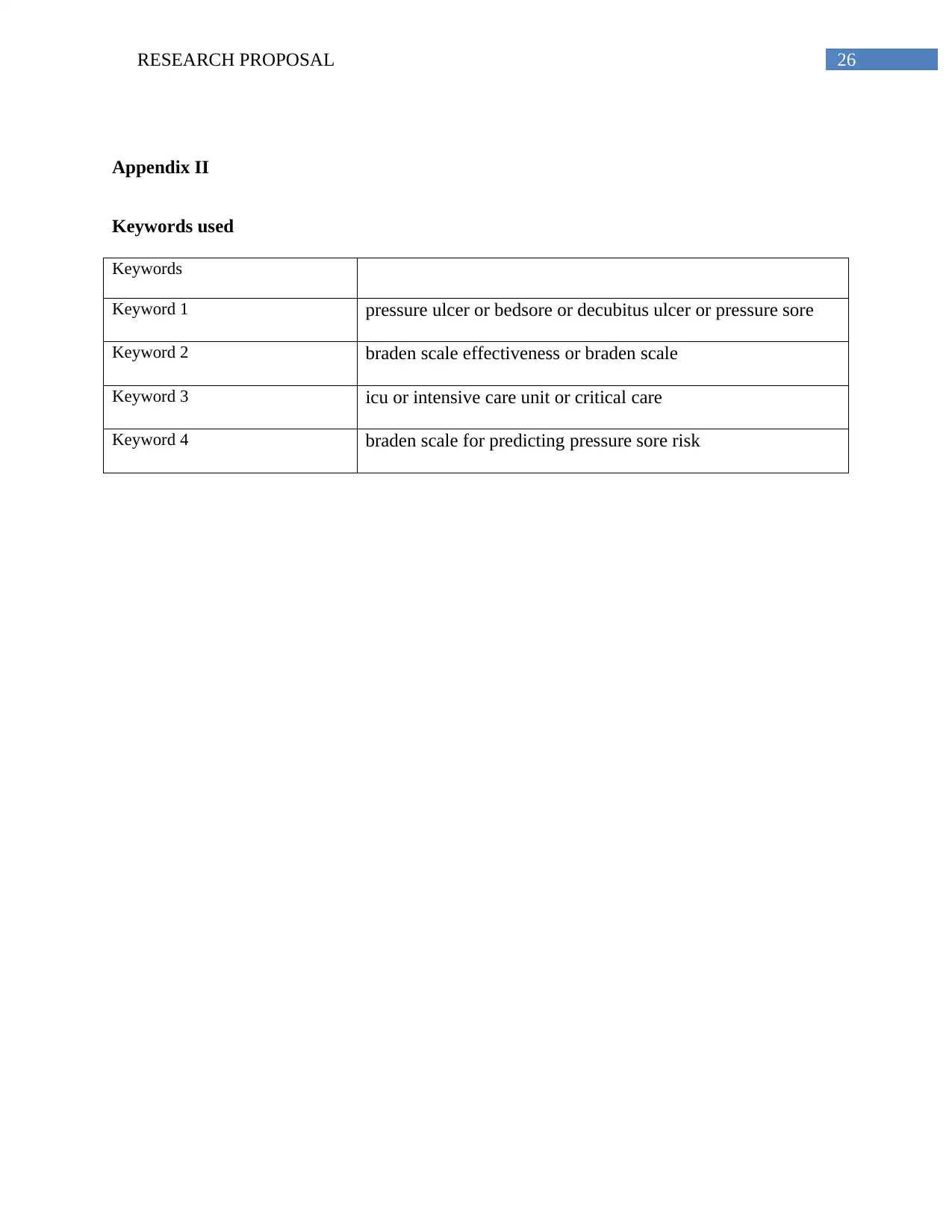
Appendix II
Keywords used
Keywords
Keyword 1 pressure ulcer or bedsore or decubitus ulcer or pressure sore
Keyword 2 braden scale effectiveness or braden scale
Keyword 3 icu or intensive care unit or critical care
Keyword 4 braden scale for predicting pressure sore risk
⊘ This is a preview!⊘
Do you want full access?
Subscribe today to unlock all pages.

Trusted by 1+ million students worldwide
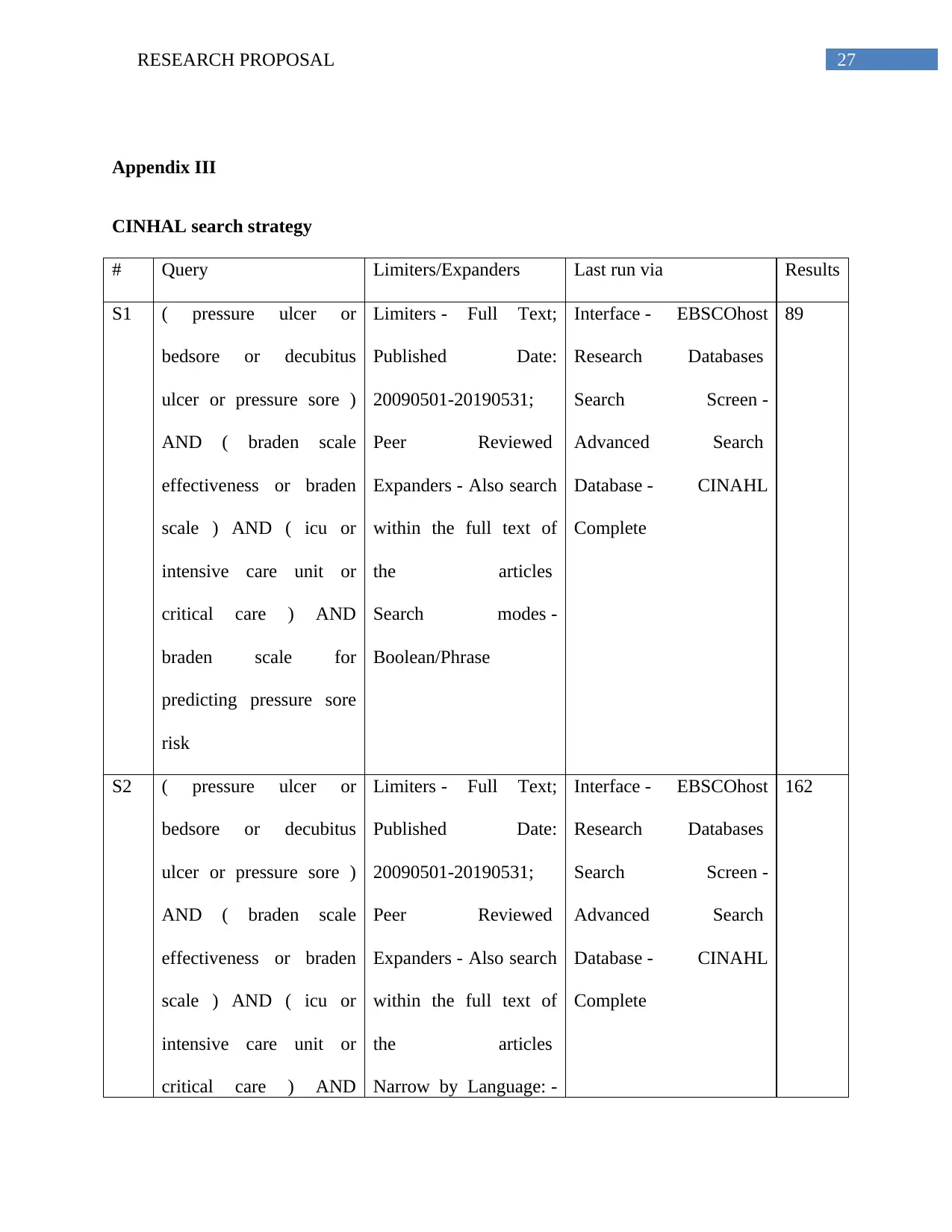
Appendix III
CINHAL search strategy
# Query Limiters/Expanders Last run via Results
S1 ( pressure ulcer or
bedsore or decubitus
ulcer or pressure sore )
AND ( braden scale
effectiveness or braden
scale ) AND ( icu or
intensive care unit or
critical care ) AND
braden scale for
predicting pressure sore
risk
Limiters - Full Text;
Published Date:
20090501-20190531;
Peer Reviewed
Expanders - Also search
within the full text of
the articles
Search modes -
Boolean/Phrase
Interface - EBSCOhost
Research Databases
Search Screen -
Advanced Search
Database - CINAHL
Complete
89
S2 ( pressure ulcer or
bedsore or decubitus
ulcer or pressure sore )
AND ( braden scale
effectiveness or braden
scale ) AND ( icu or
intensive care unit or
critical care ) AND
Limiters - Full Text;
Published Date:
20090501-20190531;
Peer Reviewed
Expanders - Also search
within the full text of
the articles
Narrow by Language: -
Interface - EBSCOhost
Research Databases
Search Screen -
Advanced Search
Database - CINAHL
Complete
162
Paraphrase This Document

braden scale for
predicting pressure sore
risk
english
Search modes -
Boolean/Phrase
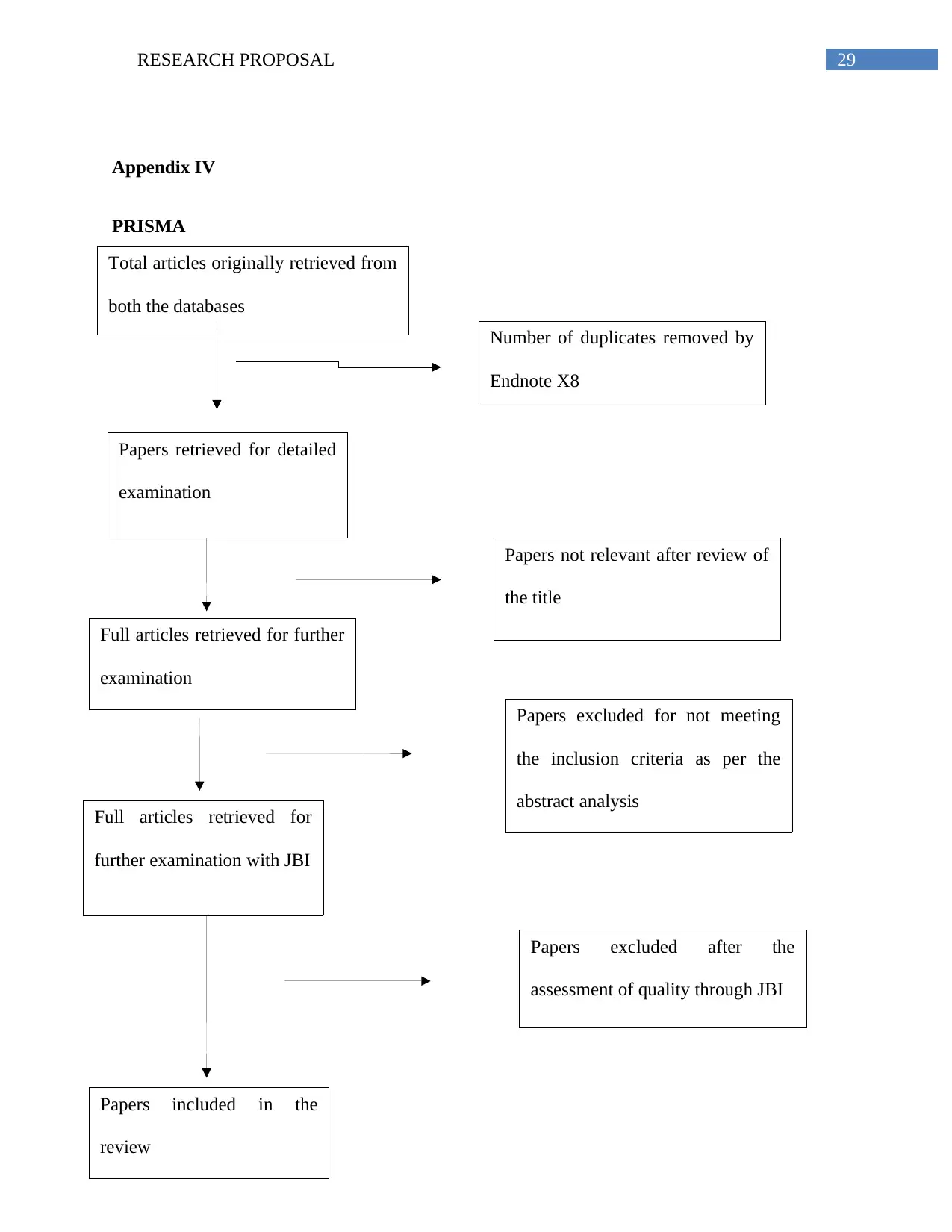
Appendix IV
PRISMA
Total articles originally retrieved from
both the databases
Number of duplicates removed by
Endnote X8
Papers not relevant after review of
the title
Full articles retrieved for further
examination
Papers retrieved for detailed
examination
Papers excluded for not meeting
the inclusion criteria as per the
abstract analysis
Full articles retrieved for
further examination with JBI
Papers included in the
review
Papers excluded after the
assessment of quality through JBI
⊘ This is a preview!⊘
Do you want full access?
Subscribe today to unlock all pages.

Trusted by 1+ million students worldwide

Related Documents
Your All-in-One AI-Powered Toolkit for Academic Success.
+13062052269
info@desklib.com
Available 24*7 on WhatsApp / Email
![[object Object]](/_next/static/media/star-bottom.7253800d.svg)
© 2024 | Zucol Services PVT LTD | All rights reserved.





